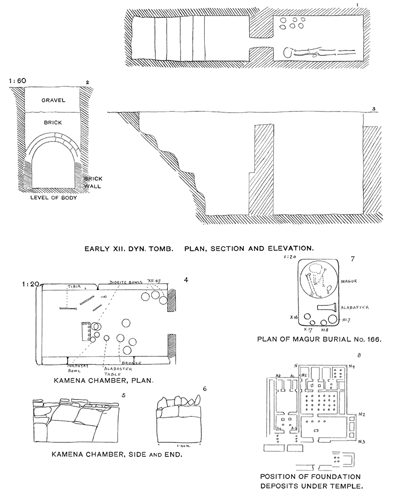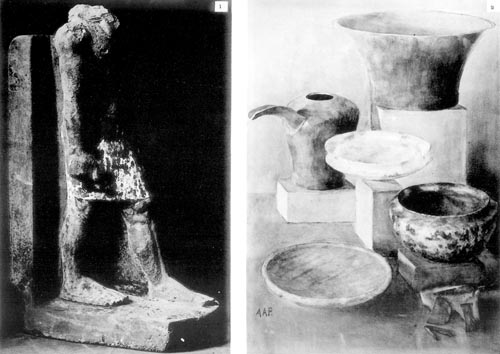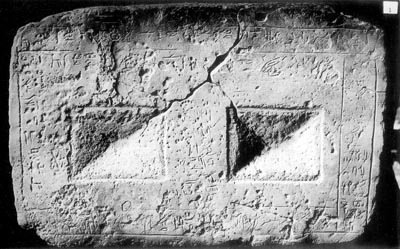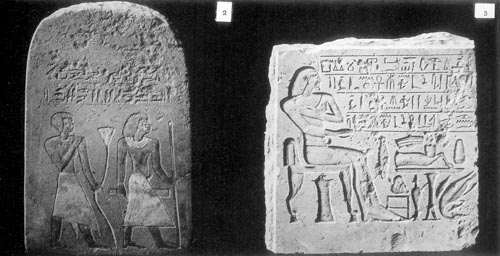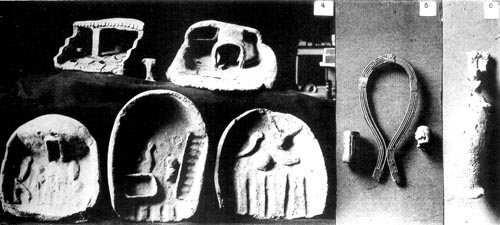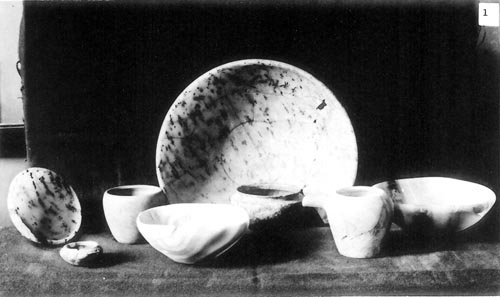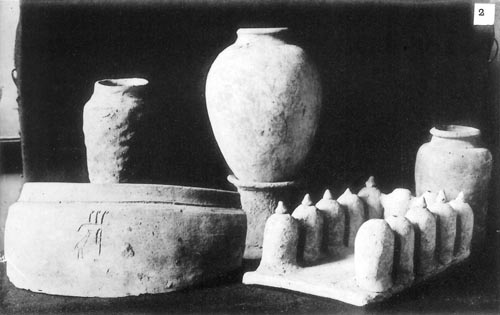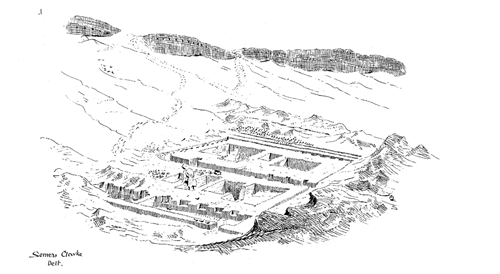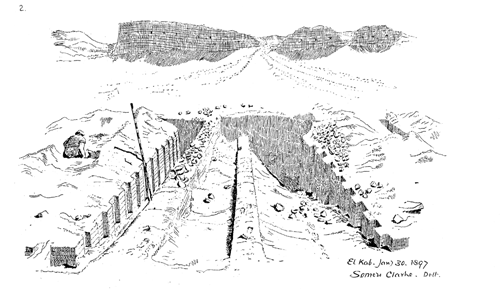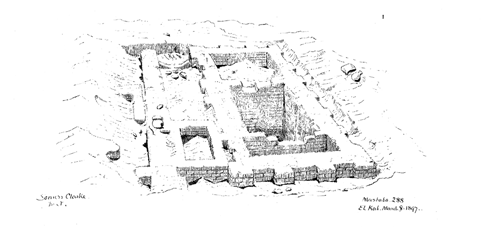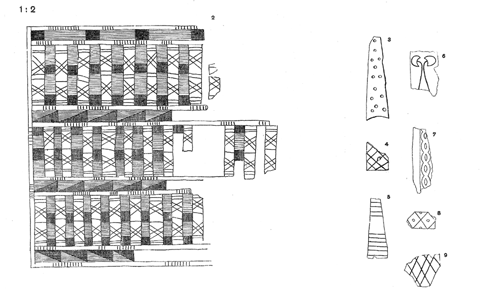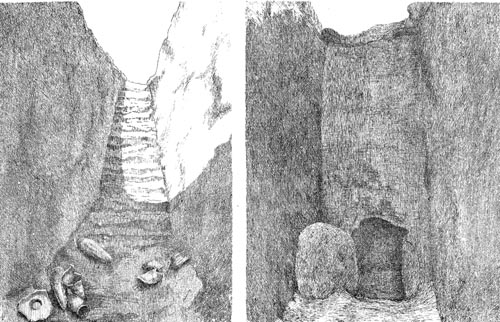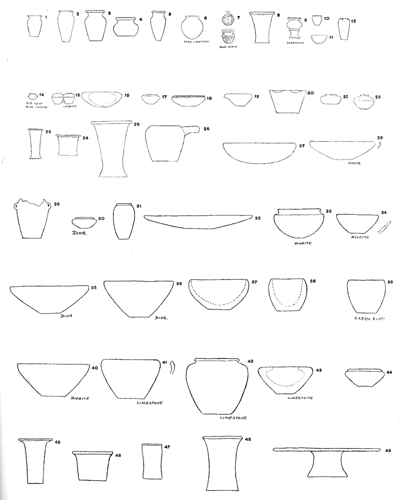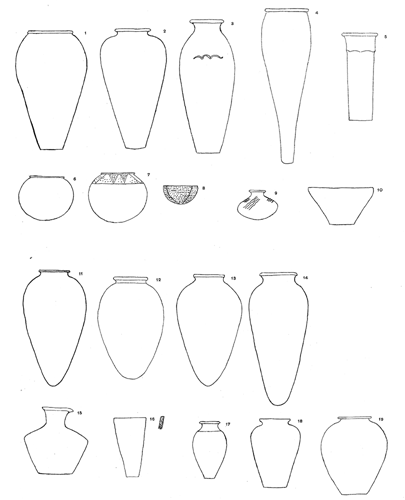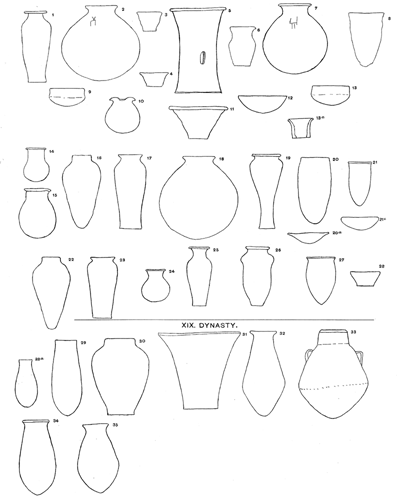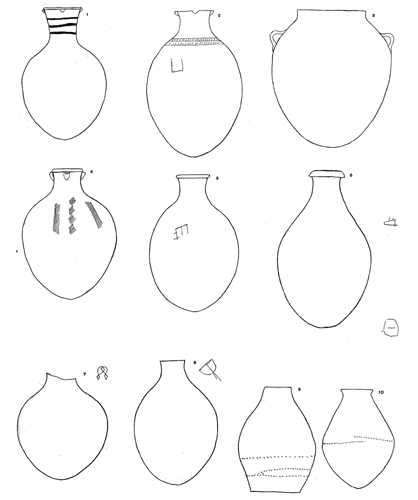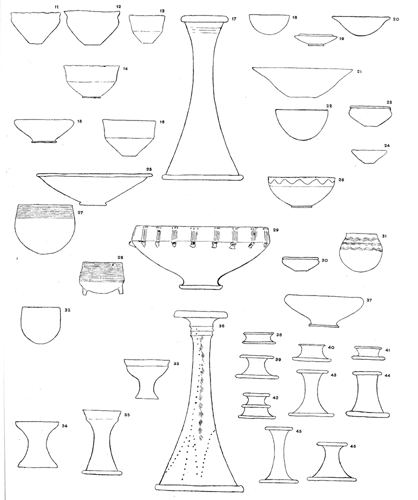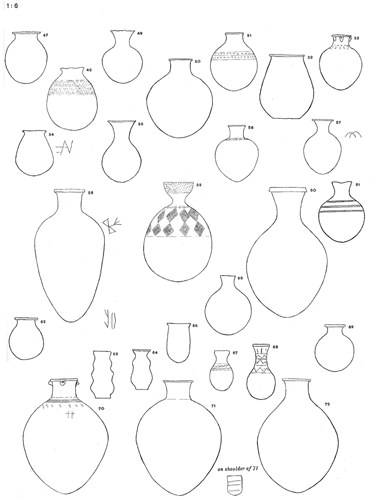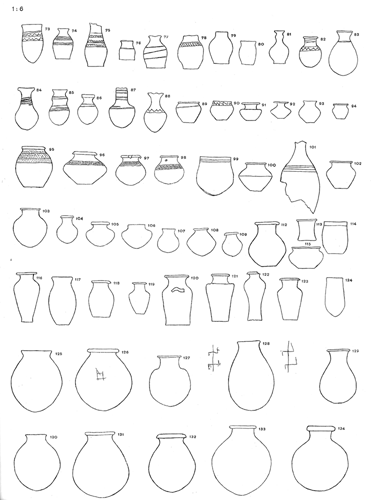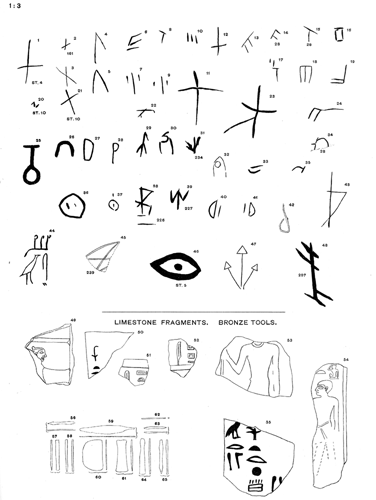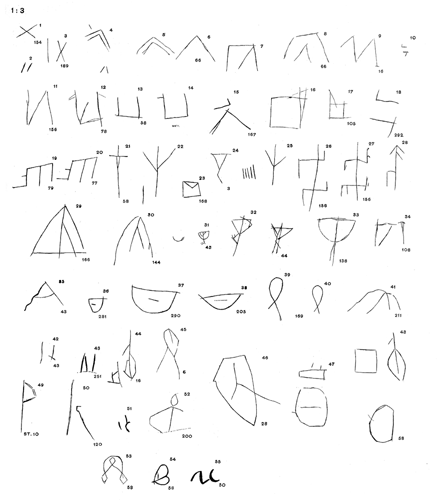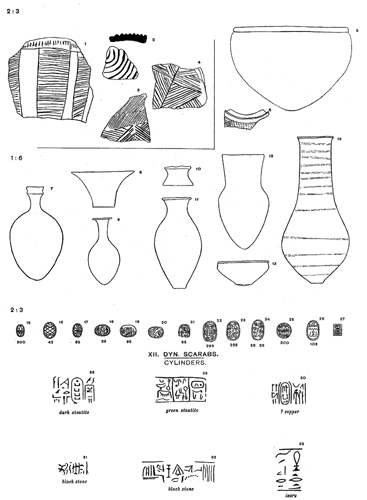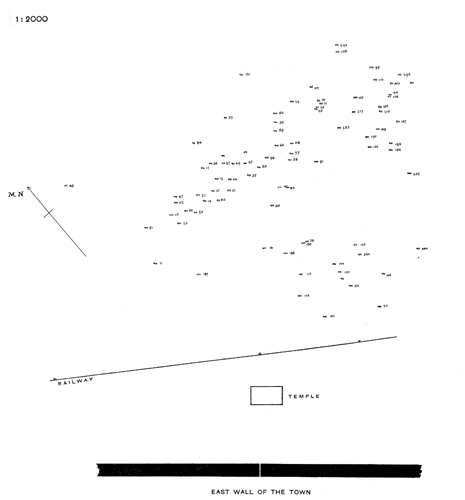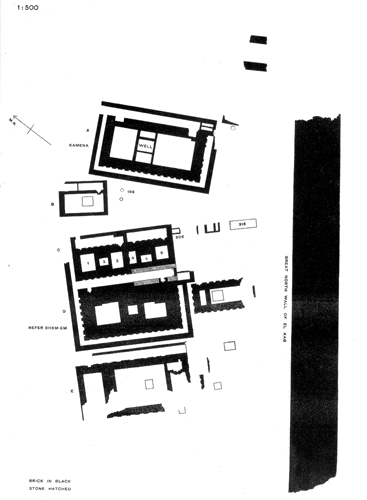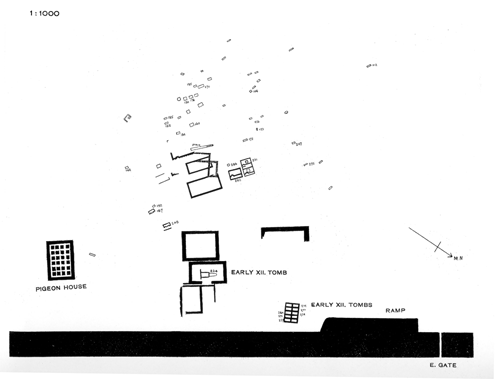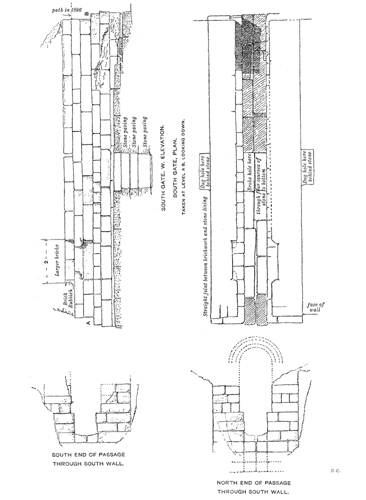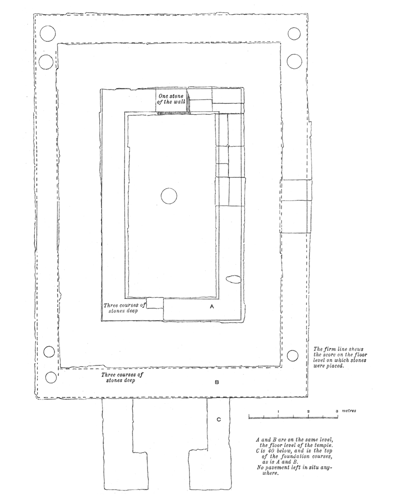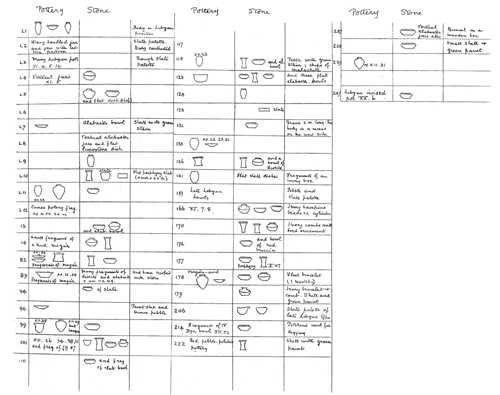The Project Gutenberg EBook of El Kab, by J.E. Quibell
This eBook is for the use of anyone anywhere at no cost and with
almost no restrictions whatsoever. You may copy it, give it away or
re-use it under the terms of the Project Gutenberg License included
with this eBook or online at www.gutenberg.org
Title: El Kab
Author: J.E. Quibell
Release Date: December 9, 2008 [EBook #27466]
Language: English
Character set encoding: ISO-8859-1
*** START OF THIS PROJECT GUTENBERG EBOOK EL KAB ***
Produced by Steven Giacomelli, Jason Isbell, Anne Storer
and the Online Distributed Proofreading Team at
http://www.pgdp.net (This file was produced from images
generously made available by Case Western Reserve University
Preservation Department Digital Library)
Transcriber’s Notes:
1) [.a] = dot above a
2) Spelling of Sneferu / Snefru left as in the original.
3) Any reference to scale (eg: ⅓ life-size) has been left as in
the original - however as the reproduction of images varies from
the original, these are no longer accurate.
EGYPTIAN RESEARCH ACCOUNT,
1897.
EL KAB.
BY
J. E. QUIBELL.
IN ASSOCIATION WITH THE WORK OF
SOMERS CLARKE and J. J. TYLOR.
LONDON:
BERNARD QUARITCH, 15, PICCADILLY, W.
1898.
LONDON:
PRINTED BY WILLIAM CLOWES AND SONS, Limited,
STAMFORD STREET AND CHARING CROSS.
CONTENTS.
| INTRODUCTION. |
| sect. | | page |
| 1. | Course of work | 1 |
| 2. | Chance of inscribed tombs | 2 |
| 3. | Description of site | 2 |
| | |
| CHAPTER I. |
| The Earliest Tombs. |
| 4. | Mastabas and stairway tombs | 3 |
| 5. | Ka-mena mastaba | 3 |
| 6. | A mastaba | 4 |
| 7. | Compound mastaba | 4 |
| 8. | Nefer-shem-em | 5 |
| 9. | Early black cylinder | 5 |
| 10. | Smaller mastabas | 5 |
| 11. | Stairway tomb with inscribed cylinder | 7 |
| 12. | Open graves | 8 |
| 13. | Majūr and cist burials | 9 |
| | |
| CHAPTER II. |
| Date of the “New Race” Remains. |
| 14. | Variety of names | 11 |
| 15. | First dating erroneous | 11 |
| 16. | Evidence from El Kab | 12 |
| 17. | From other sites | 12 |
| 18. | Doubtful points | 13 |
| | |
| CHAPTER III. |
| Middle Kingdom Cemetery. |
| 19. | Early XIIth dynasty tombs and the wall | 13 |
| 20. | Tombs in detail | 14 |
| 21. | Later XIIth dynasty tombs | 14 |
| 22. | Beads | 15 |
| | |
| CHAPTER IV. |
| New Empire Monuments. |
| 23. | Few XVIIIth dynasty remains | 15 |
| 24. | Temple of Amenhotep III. | 16 |
| 25. | Foundation deposits | 16 |
| 26. | Temple near the east gate | 17 |
| 27. | The date of the wall | 17 |
| 28. | Bronzes | 17 |
| 29. | Pigeon-house | 17 |
| | |
| CHAPTER V. |
| Description of the Plates. |
| 30. | Plate I. | 17 |
| 31. | Plates II-VI. Photographs | 17 |
| 32. | ” VII-IX. Mastabas and tombs | 19 |
| 33. | Plate X. Alabaster vessels | 19 |
| 34. | Plates XI-XII. Libyan and early pottery | 19 |
| 35. | ” XIII-XVII. XIIth dynasty pottery | 19 |
| 36. | ” XVIII-XIX. Marks on pottery | 20 |
| 37. | Plate XX. Pottery, scarabs, and cylinders | 20 |
| 38. | ” XXI. Foundation deposits | 20 |
| 39. | Plates XXII-XXVI. Plans | 21 |
| 40. | Plate XXVII. Contents of tombs | 21 |
LIST OF PLATES.
| I. | Tomb plans. |
| II. | Old Empire stone vases, etc. (photographs). |
| III. | Sandstone statue of Nefer-shem-em, and group of objects
from the tomb of Ka-mena (photographs). |
| IV. | Sandstone table of offerings and two stelæ (photographs). |
| V. | XIIth dynasty statuette and ushabti, a late bronze, etc. (photographs). |
| VI. | Diorite, alabaster and pottery vessels of Old Empire (photographs). |
| VII. | Sketches of mastabas. |
| VIII. | Sketch of a mastaba, and box of ivory and glaze veneer. |
| IX. | Views of a stairway tomb. |
| X. | Alabaster vessels, XIIth and IVth dynasties. |
| XI. | Libyan and Old Kingdom pottery. |
| XII. | Old Kingdom pottery. |
| XIII. | Pottery, early XIIth dynasty. |
| XIV. | XIIth dynasty water-jars. |
| XV. | ”” pottery. |
| XVI. | ”” ” |
| XVII. | ”” ” |
| XVIII. | Marks on Old Kingdom pottery. |
| XIX. | ” Middle Kingdom pots. |
| XX. | Pottery, scarabs and inscribed cylinders. |
| XXI. | Foundation deposits. |
| XXII. | Plan of cemetery E. of town. |
| XXIII. | ” mastabas N. of town. |
| XXIV. | ” tombs in S.E. angle of the enclosure. |
| XXV. | Plan of gateway in wall. |
| XXVI. | ” temple of Thothmes III. |
| XXVII. | Catalogue of small Libyan tombs. |
[Pg 1]
INTRODUCTION.
1. It was on Mr. Somers Clarke’s proposition that
El Kab was selected for last winter’s work of the
Research Account. Mr. Clarke has for some years
been interested in this site, and has published some of
the XVIIIth dynasty tombs there. He wished to
see the smaller tombs excavated, and the great area
inside the town examined, so, with his colleague,
Mr. J. J. Tylor, he offered a considerable subscription
to the funds, on condition that El Kab should be the
selected site. To Mr. Jesse Howarth, equally with
these gentlemen, we are indebted for that support
without which the excavations could not have been
carried out.
We arrived at El Kab on the 1st of December, and
within four days had cleared out several of the
uninscribed tombs in the famous hill, and had made
them into a most comfortable house. Nothing in
Egypt makes so pleasant a dwelling as a rock-tomb.
In a house in which window and door are one, and
three sides and the roof are of solid rock, there can be
no draughts, and the range of temperature night and
day is very small. We had a room each, another for
a dining-room, and in two more I packed away my
forty workmen. These were nearly all men known in
previous years at Kuft and Naqada, for the natives of
El Kab are few in number and of inferior physical
strength, so that their labour at two piastres a day
was dearer than that of the picked Kuftis at four.
All the conditions of work were very pleasant, much
better than I have known in Egypt before. No crowd
of loiterers and dealers’ spies haunted the work as at
Kuft, no robbery by workmen threatened us as at
Thebes. Surveying poles were left out for weeks
together; at most villages they would have been
stolen the first night for firewood.
There was some delay in getting the necessary
permission for digging; after a fortnight’s waiting
we received it, and began to work upon the XIIth
dynasty cemetery. Halfway through March the
digging was gradually brought to an end, and map-making
and packing occupied the time till we left in
the beginning of April. Fifty-four boxes of pottery
and other objects were brought to England, were
exhibited during the month of July at University
College, and were then dispersed to various museums,
Oxford, Philadelphia, Chicago and Manchester, receiving
the largest shares. I have to acknowledge
much help received both in Egypt and England. To
Mr. Clarke, besides the financial support mentioned
already, we owe thanks for help in the work of excavation,
in plan-making, drawing, etc., and for his
untiring hospitality. To Miss A. A. Pirie, who was
with us for the later two-thirds of the season, we are
indebted for several coloured drawings of tombs, etc.,
now at University College, and to her, as also to my
sister, for constant aid in the varied daily occupations
of the digger, tasks in which their experience makes
them most valuable helpers, and which they cheerfully
added to the labours of desert housekeeping. In
England, several friends have helped in the work of
unpacking, exhibiting, drawing plates, etc., notably
Miss Griffith, Miss Murray, Mr. Herbert Thompson
and Dr. Walker. Few outside the little ring of
diggers and their friends know how much drudgery
in Egypt and in England is taken off our hands
by friendly helpers, working without a thought of
reward.
2. The site of El Kab is a large one. The area
inside the town walls alone would have required to
clear it five times the money we had at our disposal;
and besides that, there was the hill of XVIIIth
dynasty tombs, the cemeteries outside the walls, and
the temples far up on the desert. It was necessary
to make careful choice of such spots as would repay
the labour expended on them. The most obvious
[Pg 2]
place to search would be the sandstone hill in which
we lived, where the fine inscribed tombs of Paheri
and Aahmes are well known. But is there much
chance of finding inscribed tombs anywhere in Egypt
except at Thebes? We know that the tomb was left
open for the visits of relatives, and open it must
always have remained, unless it got drifted up with
sand, or unless the quarrying of another tomb on a
higher level sent down a mass of chips which hid it.
At the capital, tombs were often lost for long periods
in this way; in less crowded cemeteries the accident
would seem to be less likely to happen. Many traces in
the existing tombs at El Kab show that earlier tombs
were quarried away in order to make room for them.
This would seem to minimise the chances of finding
anything valuable of early date; and if by chance
some inscribed tomb still remains hidden in the
talus of chips in the lower part of the hill, the
business of making a thorough search there would be
so long and expensive that it will probably remain
undiscovered.
3. The greatest monument at El Kab is the town
wall, the huge mass of which must arrest the attention
of every passer-by on the river. It encloses a great
square of about 580 yards in the side; the walls are
40 feet thick, and in most places still reach a height
of 20 feet. The diagonal of the square runs, roughly,
N. and S., and the S.W. wall is parallel to the river.
The S.W. corner has disappeared; indeed the river
now runs over the point where it must have stood.
There is evidence that the Nile has moved eastward
at this point, but not to any great extent, within the
last 2000 years, for some remains of a landing-stage,
believed to be Roman, can still be seen a little south
of the town. About a quarter of the area inside the
walls was cut off from the rest by a curved double
wall, and only inside this smaller area are there many
traces of buildings. Here, in the early part of the
century, was a large mound, but now the sebakhin
have carried it all away, and we look over a most
desolate space, at one part red with the broken pottery
of all periods, thrown out from the sebakh-digger’s
sieve, at another white with the salt that everywhere
permeates the soil. A few great brick walls remain,
and the foundations of the temple, but no part of the
superstructure. Outside this town, but inside the
great square of the walls, the character of the ground
is quite different. There are no great masses of
pottery, hardly any brick walls; in the lower parts
little parallel ridges in the soil show that cultivation
has been carried on there within the last few years;
for the rest, the ground is covered with pebbles, much
like the untouched desert, and here and there are
fragments of pottery, evidently of early date. These
were most numerous on two or three slight rises
which, as we afterwards found, had contained groups
of tombs. Thus, on the day we arrived, was presented
the first puzzle of El Kab. The greater part of the
enclosure had never been inhabited, at least by people
living in houses and using pottery. What, then, could
have been the purpose of the huge walls? The north
wall (strictly, the north-west, but called north for convenience)
could be crossed by walking up the great
sand-slope, which reaches to its top on both sides.
This is driven up by the prevalent north wind. A
similar, but much smaller, heap has drifted against the
north side of the south wall. From the top of the
north wall one has a good view of the whole neighbourhood.
The town lies at the mouth of a wide
valley, flanked by broken ranges of sandstone hills.
An hour’s walk up this valley is to be seen the little
square block of Amenhotep III’s temple, the great
isolated rock of the graffiti, and, rather nearer, the
small temple of Rameses. The low hill to the left,
half a mile away, is the hill of tombs. The row of
black dots sloping downwards to the east are the doorways
of the tombs; they follow the bed of soundest
rock. Further to the north is a rock looking, in the
distance, like a huge mushroom. This is a hill of
which there remains only the upper part, resting on
great pillars; the flanks of the hill and all the inside
of it except these pillars have been quarried away,
the stone being used probably for the temples of
El Kab. The strip of cultivated land is very narrow
at this part, often less than 500 yards wide.
Immediately to the east of the walls the ground
has been disturbed, being covered with small and
equal rises and depressions; scraps of XIIth dynasty
pottery scattered over its surface showed that here
was the cemetery of the Middle Kingdom.
Note.—I stopped for five hours at Kafr-es-Zaiat on
the railway journey from Alexandria to Cairo to
examine a site, which may be the Serapeum of the
Saite nome. On the map, in the Description de
l’Egypt, some ruins are marked as the village of
El Naharieh, north of Kafr-es-Zaiat. I found, on
talking with the people, that ruins had existed there
thirty years ago, but that now all the ground they
had covered had been brought into cultivation.
Under the mats in the mosques some blocks of
granite of old Egyptian work may be seen, and I
[Pg 3]
noticed the cartouche of Necho twice. The sheikh
of the village had, too, a fine lintel, used as a gate-post.
This he kindly had moved for me, and on it I saw the
name of the Serapeum of the Saite nome, Hat-biti,
again with the cartouche of Necho. (Cf. de Rougé,
Géographie de la Basse Égypte, p. 22.)
CHAPTER I.
THE EARLIEST TOMBS.
4. The lower parts of the ground inside the enclosure
had been very thoroughly looted, chiefly by
the natives of El Kab, when cultivating. We found
many small graves about 6 feet long, 2 feet wide, and
waist deep, but containing no bones, and with so
little pottery in them that it took some time to
determine their period. But in the two low mounds
to the north, and the larger one in the south, graves
of several kinds soon appeared. Of these one set
were clearly later than the rest. Their enclosure
walls, within which several burials were found, were
at right angles to the great wall of the town, and cut
through the other graves (mastabas) which, though
parallel to one another, were skew to the town walls.
These earlier tombs were of several types: (1) mastabas
with square shafts; (2) mastabas with sloping
“stairways,” both of crude brick; (3) burials in the
kind of large earthenware pot that our workmen call
a majūr; and (4) burials of that now well-known
type which has been called New Race, Libyan,
Neolithic, etc., and which is distinguished by the
contracted position of the body with the head to the
south, and by a very definite class of pottery, paint
slabs, beads, etc. The mastabas were found both
within and outside of the town walls, one group
(Pl. XXIII) lying quite close to them. On three
diorite bowls found in these graves (one inside the
walls, the others outside) the name of Sneferu
appeared. As this is the only king’s name occurring
in any of these tombs, it seems probable that most of
them may belong to the reign of Sneferu, or to the
period immediately following. And the town walls,
being built through the Old Kingdom cemetery, are,
of course, the later in date.
About thirteen “stairway” tombs and thirty-seven
mastabas were examined. The precise number
cannot be given, for when the walls of the mastaba
are entirely denuded, and only the well is left, one
cannot be sure that the grave was ever of the mastaba
form. Of smaller graves which yielded any
evidence, there were about fifty-three; but many
more, which, from their position, orientation, and size,
could be assigned to the early period, were quite
empty, or contained only a few potsherds.
5. The most important mastaba was that of Ka-mena
(Pl. XXIII). It is one of a group which we
found under the great mound of drifted sand on the
north side of the wall. Pl. VII gives two views of
this group of tombs during the process of excavation.
The low walls are denuded near the end of the sand-slope
to a single brick’s height; in the centre they
are a metre high, and they sink again towards the
end under the great wall. They are built with
recessed panels, and were originally plastered and
painted white. Round the whole tomb runs a
boundary wall. The two small closed chambers at
the end of the last passage (corresponding to those
which, in the tomb of Nefer-shem-em, contained his
two statues) were empty, but a few fragments of the
legs of a small sandstone statue were found near. In
the E. wall itself there are two niches; in and near
them were found many small pieces of worked limestone,
some inscribed. They are copied in Pl. XVIII,
49-53 and 55. The face in 49 retained a
touch of green paint on the cheek, an important piece
of evidence for the dating of the Naqada tombs, the
occupants of which also used this method of adorning
themselves. The pieces, 53 and 54, seem to be parts
of a stela; 50 and 55 are from the bases of limestone
statues.
The inscriptions give us Ka-mena’s name, and
show him as a king’s acquaintance and a priest.
The chambers inside the mastaba, left blank in the
plan, were found filled with brick earth; this was
cleared out, but nothing save a scrap of IVth dynasty
pottery was found. The earth was doubtless thrown
in in this way to economise bricks; the cross walls
would serve only to keep this loose earth from falling
down the well in the centre. The well was about
15 feet deep, filled with thick, damp clay, the bottom
being, even in January, very near the water-level.
The chamber was to the south, closed by a rough-hewn
slab of sandstone three inches thick. It should
be noted that the sandstone in the neighbourhood
breaks naturally into very flat plates, so that it is
easy to pick out slabs which, with very little dressing,
will serve for building; such pieces were found in
many of the early tombs. This slab being removed,
the chamber was found to be full of a very tenacious
clay, much of which had to be cut away with a knife,
for in so tough a substance a light blow with an adze
[Pg 4]
has no effect, and a heavy one may damage some
valuable object before it can be seen. The whole
chamber was lined with flat sandstone blocks, but the
thin roof slabs had given way under pressure of the
earth above. The style of building was irregular
(v. Pl. I), the blocks being fitted, but not squared.
The body had lain on the west side, with its head
north; no trace of a coffin remained, and the bones
were a mere white paste, only to be distinguished by
scraping sections with a knife through mud and bone.
Under the whole body was a bed of white sand.
Near the entrance were six vases (XI, 12), of a shape
and fabric indistinguishable from a late Neolithic
form common at Naqada, and opposite the middle of
the body was a group of important objects. These
were: a model granary in rough red pottery (Pl. VI),
each little storehouse having an opening above,
closed by a stopper; another similar granary in
fragments, three vertical alabaster jars, an alabaster
circular table, and the group of bowls and model
tools shown in Pl. III. These last consist of—
(1.) A bowl and ewer, probably of copper, not of
bronze.
(2.) A bowl of porphyry, a flat bowl of a beautiful
light-coloured and translucent diorite, and a flat dish
made of a darker variety of the same stone. This
last is inscribed with the Ka name of Snefru, Neb
Maat, the chisel-like sign of the maat being written on
the convex side of the sickle, and the door-frame of
the name surmounted by a hawk.
(3.) A set of model tools, axe, knife, adzes and
chisels, shown again in outline on
Pl. XVIII, 56-65.
These have been analysed by Dr. Gladstone, who
writes as follows:—
“The largest fragment gave—
Per cent.
Copper 98·4
Arsenic 0·3
Iron 0·2
Bismuth trace
Lead trace
Antimony trace?
Oxygen as cuprous oxide trace
It is, of course, essentially copper, the minute quantities
of the other constituents being due, in all
probability, to impurities in the ore. The total
absence of tin is the most notable feature.”
6. The small mastaba W. of Ka-mena’s is of simpler
construction. The brickwork may have been recessed,
though this could not be ascertained, as its
walls were only two bricks high, and the panelling in
the other mastabas does not reach so near the ground.
There is no enclosing wall, but there is a passage on
the east side, with low cross walls which I do not
understand. The chamber at the bottom of the well
is to the south; it was not closed by a stone. Near
the mouth, to the east, was a small coffin of red
pottery; its size showed it to be that of a child buried
in a contracted position. Between the coffin and the
side of the chamber was a diorite bowl; south of this
were two vertical jars and a circular table, all of
alabaster. On the west side of the chamber lay the
body, on its left side, and with the head north; the
arms and legs were sharply bent, the heels being
brought close to the hips.
7. To the west of this is the compound mastaba
marked C in the plan. The southern half was built
later than the northern, the panelling of which can be
seen inside the first well beyond the cross wall. The
spaces marked 1, 3 and 6 are only chambers filled
with clay; 2, 4 and 5 are all tomb wells.
The well (4) was exceptional in that its chamber was
to the west and not to the south. It was 5·3 m.
deep, and scattered through the earth in it were
coarse pots of the types in Pl. XII
(23, 30, 31, 33, 34, 40). Inside the chamber were two vertical alabaster
jars, a circular table, a diorite bowl, fragments
of malachite, a small river shell containing white
paint, and one of the pots (XI, 12) like those in Ka-mena’s
tomb.
At the bottom of the next well (5) stood one of the
large hemispherical pots (majūrs) which were used as
coffins (XX, 5). It was 60 cm. in diameter, but was
empty and inverted. Against the mouth of the
chamber was a stone slab two metres high, one side
of it much broken away. The chamber was, as in all
these tombs, filled with thick mud, and scattered
through this mud, or on the floor, lay the following
objects: a diorite bowl of the ordinary shape, containing
a small vase of alabaster inverted over a mass
of green paint (malachite), a smaller bowl also of
diorite, an alabaster table upside down, and two more
alabaster vessels.
Below these lay what once had been a very curious
box. The pattern of the lid is shown in Pl. VIII, 2.
It is composed of small flat strips of ivory, 1 mm. thick,
and of pieces of glaze, blue and black; these had
apparently been glued on to a background of wood,
but this had entirely decayed, and the thin film of
decoration was left in the mass of heavy clay. After
clearing it sufficiently to learn its nature and size, we
drove a piece of tinplate under it, and so lifted out
the whole lump of earth in which it was contained.
[Pg 5]
Inside the house we could at leisure scrape away the
soil from one side, and pour melted beeswax in its
place, then turn the whole over and repeat the process
on the other side. In this way a large piece was
brought to England embedded in wax. This wax
was afterwards removed, and replaced on the inside
by plaster of Paris. The size of the box was about
12 inches long by 8 inches broad, and 5 inches high.
It had been much crushed, and the sides could not be
saved. The contents were a small porphyry bowl
(X, 44), a shell, and some green paint.
8. The mastabas C, Ca, and D were contained in
the same boundary wall. C appears to be the earliest,
then Ca, then D. The inner half of the passage
between C and D is lined with stone; at the end,
bricked up in a little chamber, were found the two
statues of Nefer-shem-em; to him, therefore, belonged
the tomb D. The statue to the west was in sandstone
(Pl. III),
a standing figure, ⅓ life-size; the head was missing,
only a few fragments of it being
found below the statue. The surface of the stone
had been covered with a fine layer of plaster, reddened
with haematite, of which some traces remained;
the skirt was painted white.
The other statue of limestone represents Nefer-shem-em
seated. The head is well preserved, and
the whole statue is a good example of Old Kingdom
work, though not of the most finished style, and much
damaged by salt. It does not show the “Schminkstriche.”
The inscriptions incised on the base of the
standing figure, and on the right side of the chair of
the seated one, are the same:—
Suten rekh se hez neter hon Nefer-shem-em.
(Number in Ghizeh Catalogue, 650.)
The mastaba D of Nefer-shem-em is of the
ordinary type, with two niches on the east, two
chambers filled with brick earth, and a central well.
This well was filled with bodies, not buried with care,
but thrown down in every contorted attitude. The
position of twenty-three skulls and bodies was noted,
and then, as no plan or arrangement appeared, the
rest were left to be taken out by the men. A scarab
of Amen-ankh-as, found in one of the bodies on the
upper level, appears to give the late XVIIIth
dynasty as the date for this mass of burials.
9. The next mastaba (E) is of a curious form; the
S. niche is over one of the wells instead of being in
the outer wall. Both wells were cleared until we
were stopped by water. From one came the fragments
of a pottery sarcophagus of the small type.
The small mastaba (301) nearer the town wall was
of more interest. In its well were found fragments of
the rough early pottery (Pl. XII), of the short type
of earthenware coffin, and of a majūr (XX, 5), also a
piece of a diorite bowl, on which the name Sneferu
had been very roughly scratched, and a small
(¾-inch)
black stone cylinder (XX, 32). This is of a
type already fairly well known from bought specimens
(there are twenty-one in the Edwards Coll.), and
suspected to be early, but not hitherto found by a
European. The engraving shows a figure seated
before a table and wearing a huge wig.
10. The next mastaba (No, 288) was inside the
town. Just to the south of the tomb passage, as if
thrown out from it, lay a great many pots of coarse
pottery of the shapes shown in the top of Pl. XII.
These pots were also found in the passages between
mastabas, and fragments of them in very great
quantities were scattered over the tombs, especially
over those of the “stairway” type. This suggests
that the coarse pottery was used, not in the interment,
but for the offerings brought by relatives to the
tombs. They were placed, probably, opposite the
niches, and when they became inconveniently numerous,
were thrown away over the tomb wall. Several
hundreds of these pots were found, heaped together,
behind two mastabas to the north of the wall
(Pl. VII, C, D).
The tomb had been robbed. Fragments of one of
the large, circular, bowl coffins (XX, 5) were scattered
through the earth all down the shaft, and the great
slab which had closed the door was thrown over at
the bottom of the well. The chamber was empty,
but under the flat stone were found fragments of a
slate dish, of an alabaster table, and of four diorite
bowls. Of one of these, the largest I have seen
(Pl. II, 1),
more than two-thirds of the pieces remained;
it was inscribed, in neat, deep characters,
suten biti Sneferu, the name of the king being written
without the cartouche. In this tomb was also one of
the coarse bars of pottery that I have found both in
Old Kingdom and in Neolithic tombs, the use of
which is by no means clear. They were, when
complete, about 2 feet 6 inches long, and 4 inches
thick; they are flat on one side, rounded on the
other. The sides of one Neolithic tomb at Ballas
were lined with bars of this kind. In another, the
body was sheltered by a large inverted dish resting
upon several of them; frequently fragments of two or
three were found in a tomb. Perhaps they were used
as supports for the coffin.
[Pg 6]
In tomb No. 312, which was probably a mastaba,
though the walls were not observed, the well was but
2 metres deep. The chamber was at the west, and
was just large enough to contain the pottery coffin
and a few pots. The coffin was of the short type
(3 feet long); the body lay on its left side,
crouched up, head to the N., and face E. One bone
from the foot lay outside the coffin at the foot end,
where also lay a small bowl of diorite, part of another
in limestone, bracelets in shell and horn, an ivory
hairpin, and a shell containing green paint. Through
the earth in the tomb-shaft were scattered a large
number of coarse pots (Pl. XII, two of 41, 45, 43,
a hundred and four of 22, more than a hundred
of 31).
In tomb No. 318, the burial chamber lay to the
west of the well, 2 m. above the bottom of it, 3·7 m.
from the top. The bones were scattered and broken,
but the chamber was so small that the burial must
have been a contracted one. There remained a
diorite bowl (11 inches diameter), a vertical alabaster
jar, a smaller one containing green paint, and part of
a bowl in a good red ware, of the same open shape as
the bronze bowl of Ka-mena’s tomb.
No. 315 contained a fragment of sculpture (XVIII, 55).
No. 319 had the regular group of alabaster
table and small and large diorite bowl, with two of
the long egg-shaped pots (XI, 12), a vase with a
spout (Pl. XII, 55), and one of the open red pottery
bowls, as in No. 318, and Ka-mena (Pl. XII, 51).
Next comes a group of tombs with square wells,
and chambers closed by a large block of stone, which
tombs are probably mastabas, although the panelled
brickwork was not found.
No. 42. A large square well, 200 m. to the N. of
the town wall. Scattered in the earth were fragments
of all the common coarse varieties of IVth dynasty
pottery, and also of the bowl-like coffins (XX, 5).
The half of an ivory cylinder (XX, 33) and the small
black cylinder (XX, 31), with an inscription which is,
apparently, not Egyptian, were found amongst them;
there was also a small slate dish, and the egg-shaped
pot (XII, 49).
No. 88, inside the town, was a well 2 metres deep.
The chamber was closed by a large stone (1·00 m. ×
·65 m.), but an entrance had been effected behind it.
There remained in the chamber four stone bowls of
the shapes so often found together (X, 22, 39, 44, 48),
and in the shaft were part of a majūr, and twenty-five
coarse pots (nineteen of XII, 23, two of 37, four of 31).
No. 101. A well, 3 metres deep, with chamber to
the south, contained, with the regular coarse pottery,
the less common shape XII, 26, and also some
fragments of the later Neolithic large vases (Naqada,
XL, 40 or 46). Necks of these same vases were in
No. 150 with the coarse pottery, and also one of the
yellow clay dolls, about 15 cm. long, representing a
woman with very long legs, and a great square-ended
wig. These dolls are well known, and were supposed
to be of the Middle Kingdom. There was no sign in
this tomb of a secondary burial, so it may be that the
dolls are even of the Old Kingdom.
No. 185. At 2·10 metres below the surface were
the pieces of a small pottery cist, a majūr (complete),
under which lay the body, in the contracted position,
the head to the south, a stone bowl, and an ivory
comb, together with a few beads, felspar discs, and
shell-shaped beads of serpentine, apparently of Neolithic
style. Forty cm. lower were some cylindrical
beads in green glaze, and shells with the stains of
green paint. In the earth above were scattered
examples of the regular series of coarse pots
(XII, 23, 31, 35, 45).
No. 187, a well 3 metres deep, contained only an
inverted pottery cist, inside which was a body lying
upon the left side, with the head to the north.
No. 191, a well 2·50 metres deep, was peculiar in
that it contained no chamber; the body was protected
from the earth above by a double roof of
sandstone slabs, supported on other slabs at the sides.
The body was sharply bent up, the knees being
nearly opposite the mouth; it lay on the left side
with the head south. At the head stood an alabaster
vase (X, 31) of a late Neolithic shape. This tomb,
but for its exceptional depth, might be classed among
the Neolithic interments.
In No. 192 the body was in an abnormal position,
for while the arms lay at full length, and the
thighs in a line with the body, the knees were so
sharply bent that heels and hips were in contact.
The head was to the north, and the face east.
No. 204 was another square well with a chamber
below, which had been closed by a thin brick wall; it
contained a square, flat, slate palette, parts of a slate
dish, and three pots of a Neolithic shape (XI, 12).
No. 228 was a square well near a group of stairway
tombs. In it were two burials, the first in a pottery
cist placed in one corner of the well at 1·5 metres from
the surface. The body was contracted, the head to
the north; the only object placed with the body was
a shell near the hips. Below this cist lay another
[Pg 7]
body in a wooden box painted white. This also was
in the sharply contracted Neolithic position, hands
and knees both before the face; the head lay to
the north, and the body was on its left side. Lower
still in the well were pots of the coarse Old Kingdom
types. Both these bodies, presumably, are secondary
burials.
No. 231 contained three pots of Old Kingdom
types (XII, 23, 54, 31), with fragments of a large
majūr (XX, 5), and one sherd of a thin ware, black
inside, and decorated outside with rows of pricked
marks. This cannot be distinguished from certain
fragments obtained in the Neolithic cemetery at
Ballas.
No. 280, a well north of the wall, sunk below water-level,
but in the filling were found the regular group
of coarse pots (XII, 31, 36, 35, 33).
In 197 the coarse pottery occurred with chips of
malachite, and in 233 with a vertical alabaster vase
and fragments of a large vase identical with a large
late Neolithic shape.
11. We next turn to the other large class of tombs,
those entered by stairways. These may all have been
mastabas. The characteristic massive brick walls
remain in several cases, in one, at least, retaining the
recessed panel work and niches. But it may be that
these stairway tombs are rather older than those
mastabas which have square wells, and it seems best
not to group them together. The appearance of
these tombs may be seen in Miss Murray’s black
and white reproduction of two sketches by Miss Pirie
(Pl. IX).
The first view shows the stairway, as seen from
below, looking northward; in the other view one is
supposed to be looking southward at the vertical
end of the shaft, the tomb entrance and the stone
door.
All these tombs were robbed, excepting, possibly,
one. This (St. 2) was the smallest tomb of the kind
that I have seen. The stair was reduced to a couple
of roughly cut steps; the total depth was only 1 m.,
and though a large stone slab had been placed as a
door to the burial chamber, a robber had only to
pierce 20 cm. of soil to get into the chamber through
the roof. The chamber, which was about a metre
square, was filled with a thick damp clay. The
bones had decayed so much that only a few parts
could be identified but distinctive fragments of the
skull, the hip ends of the two femurs, a tibia, a radius
and ulna, enabled one to see that the body had lain
on the left side with the head to the north. Before
the face was an ivory cup (shape X, 44). Below the
body was a little red dust with spots of white in it,
probably the remains of a wooden coffin painted
white.
In and below the white paste, which was all that
was left of the bones of the hand, were two nuggets of
gold (one 18 dwts. = 28 grammes) and a handful of
barrel-shaped carnelian beads mixed with very small
beads of gold. By scraping away the earth very
gently, one could see that the gold beads had been
strung together to form bands 5 or 6 mm. broad,
alternating with bands of carnelian. A gold bar,
2 cm. long, pierced with five holes, had clearly served
to hold the strings on which the beads were threaded.
There was also a bracelet of a single thick gold wire.
The total weight of gold was about 4 oz. (125
grammes). In the N.W. corner of the tomb, behind
the head, were five vessels of ivory, two very coarse
vertical jars (14 and 19 cm.), two bowls (23 and
26 cm. diameter), one with a spout (X, 26), and a
bowl of the speading shape of Ka-mena’s bronze
(XII, 51); there was also a small double vase of
limestone (X, 15). A little steatite plaque with the
inscription Neb.ra was stated by the workmen to
have come from this tomb, and there is no reason to
doubt them; but I did not actually see it in place.
The name Neb.ra is one of the three Ka names on
the shoulder of the famous archaic statue No. I at
Ghizeh, and the name on the plaque may perhaps
be the same, though it is not written in the square Ka
frame.
In the side of the tomb were two small balls of
limestone and one of carnelian, in shape and size like
playing marbles, and some fragments of malachite.
By the door were some chips of diorite bowls. The
marbles were clearly part of a set for a game
(cf. Naqada, Pl. VII), and the fact that the set
was incomplete, and that the stone bowls were
broken, makes it probable, in spite of the presence
of the gold nuggets, that the tomb had been partially
plundered. The early robbers may easily have passed
over the gold, for the moist and tough clay hides
small objects only too well; it was only the weight of
two small lumps of clay that betrayed to me the
presence of the nuggets inside.
The quantity of gold remaining in so small a tomb
shows how rich the large interments may have been,
and how strong was the temptation to rob them.
In Stairway 1 the lines of the surrounding mass of
[Pg 8]
brickwork were traced, but the walls were not high
enough to show the recessed panels, which probably
once existed.
In Stairway 6, a large tomb, coarse shapes of
pottery (XII, 23, 35) were found, and also vertical
alabaster jars, fragments of an alabaster table, and of
bowls, hairpins of ivory, and an oblong slate palette
with two stone rubbers. This was of one of the later
shapes of Naqada. There was also a large pot (of
the shape XII, 49, but larger), similar to the later
pottery of the New Race.
Stairway 5 must be counted in this group of tombs,
though it differed from the common type in three
respects. It was much larger, the brickwork being
41 metres long by 20 wide; instead of an open stairway
it had a small shaft opening into a long inclined
plane which led down to the burial chamber; the
chamber, too, was very large (7 m. square). The
recessed brickwork remained on the west side, and
the passage which led to the niche on the east side
can still be traced. The clearing of this tomb formed
a tedious task for six men during three weeks, and
nothing important was found. A pot (X, 29), found
inside the great chamber, suggested that it had been
entered during the XVIIIth dynasty, and three alabaster
vases (28 cm. high) were most probably canopic
jars from some late burial. This tomb is a prominent
object to anyone looking north from the
El Kab wall, and has the appearance of a natural
mound.
Another stairway tomb was remarkable for the
great number of coarse limestone and alabaster
vertical jars which were piled at the bottom of the
stair. There were 150 of these, but nothing else in
the tomb, except a few pieces from a bowl of brown
incised ware (XX, 1), somewhat like the rare incised
pottery found at Naqada.
Staircase 8 contained a stand of coarse pottery and
a small coarse saucer (XII, 31, 44), the rough handmade
vase (XII, 23), fragments of large water-jars of
better ware, and two alabaster bowls, one of the sharp-edged
type (XI, 33), the other of the common shape,
drawn in at the mouth (XI, 44); there were also two
mud jar-seals of flat saucer-like shape.
In Stairway 9 the sides of the shaft had been
plastered with mud. The stone door of the burial
chamber was still standing, the robbers having
apparently found it easier to force their way through
the comparatively soft earth above the great slab.
We were frequently able to trace their mode of
entrance, and found that they sank their shafts at the
deep end of the stairway, never clearing the long
flight of steps. This would seem to show that the
robberies took place while this method of burial was
remembered. This tomb contained fragments of
one of the large hemispherical pots used as coffins
(majūrs), and pieces of a large jar of polished red
ware, the lines of polish on which run lengthways;
this ware again cannot be distinguished from the
Libyan. There was also a vertical jar of veined
marble, the horizontally-pierced handle of a typical
Libyan stone vase, an alabaster bowl and a vase
(X, 43), with a couple of coarse pottery bowls of
IVth dynasty type (XII, 37).
Stairway 10 contained only the coarse pottery, but
the common jars (XII, 23) bore a series of simple
marks made before firing (XVIII, 21-4, and a
triangle).
Stairway 12 had been robbed, though the sandstone
door had not been moved. The body had
been laid in a wooden box (80 cm. long), which
nearly filled the chamber. The wood had disappeared,
but the thin layers of paint still kept their
place. The body lay on the left side, contracted, the
head to the north. A small diorite bowl stood near
the head of the coffin, and a common alabaster vase
in the earth above it. Round the bones of the arm
were carnelian beads of short barrel shape.
No. 226 was exceptional in the position of the
entrance to the tomb chamber. On descending the
stairway, one found oneself at the base of a large
well, in the east side of which, and not visible from
the stairway, stood the great door. In the filling was
found a good flint knife, of the usual early type, with
small handle, but much inferior to the finer Neolithic
work.
The contents of this series of tombs have been
given thus in detail, in order to show that the same
grouping of objects occurs over and over again, and
that they can therefore be with confidence attributed
to the original burials, though if only a single tomb
had been examined there would be no proof of the
contemporaneousness of any object in it. It will be
observed that the contents of the stairway tombs are
very closely similar to those of the mastabas with
square wells, but that objects characteristic of Neolithic
tombs—green paint, double vases, marbles, etc.—are
rather more numerous in the stairway tombs.
This makes it seem likely that the stairway tombs
here at El Kab are earlier in date than the mastabas
with square wells.
12. Next we may describe the small graves, generally
[Pg 9]
about 3-4 feet deep, in which there is no chamber
for burial, but the body is laid in the shaft or open
grave. These were found chiefly inside the fort of El
Kab, though a few were outside the walls. Some
were distinctly of Neolithic type, but of that later
variety in which the fine black and red pottery is not
found. Of the earlier type, only one small group of
twenty graves was discovered; these were well outside
the town, on the west side of the railway, and so
thoroughly cleared out that only half a dozen chips of
pottery remained to show their real nature. But of
the later kind many examples were found, and still
more numerous were the empty graves which, by
their size and position, seemed to belong to the same
class.
This type is characterised by the contracted position
of the body, the vertical jars with cordage pattern,
the square slate palettes, the flat alabaster dishes, and
four shapes of alabaster vases (X, 22, 44, 48, 31), two
of which often occur also in the mastabas. The first
group obtained were inside an oblong brick building,
which showed red in the distance, the colour being
due to the great number of broken pots of the Old
Kingdom (XII, 20, 23) scattered over it. The earth
within its walls was found to consist largely of these
pots, of which there was an unbroken layer, two feet
thick. Below this we came upon the Neolithic
tombs. The walls were of the small bricks which we
soon learnt to associate with the work of the Old
Kingdom in El Kab. It is not probable that the
walls had any relation to the tombs, for they were
not quite parallel to one another, and there were
more tombs outside these walls. But it is important
to observe that a thick layer of the coarse pottery of
the Old Kingdom here overlies Neolithic tombs. It
is just possible that the pottery may have been
thrown by cultivators upon this mound, but the
probabilities against this seemed to me very strong.
In one of these tombs (L, 2) the body was found
complete, lying on the left side, with the head to the
south. At the head end were one wavy-handled pot
of a late type (XI, 3), two vertical jars (as XI, 5),
with cordage pattern, a square slate palette, and above
these a pot (XI, 9), with decoration in wavy red
lines; also an alabaster cup (X, 38), containing six
finger-bones. At the other end were a bowl, and two
vases of well-known forms.
The middles of the graves were generally empty,
and bones were rarely found; the stone bowls, which
formed the bulk of the finds, were at the north and
south ends. It does not seem worth while to transfer
from the notebooks the full description of each of
these small tombs, for they have been so thoroughly
robbed and turned over that the position of the
different objects in the tomb has no particular
meaning, but it may be well to give a short catalogue
of the objects found (v. Pl. XXVII). Each of the
tombs is about 1·50 m. to 2·00 m. long, ·90 m. wide,
and 1·50 deep.
In one tomb (No. 237) the body was laid in a
wooden box (length not seen, ·40 m. broad, wood
3 cm. thick), in a contracted position, with the head
to the south, but the bones were disturbed, and the
pottery lay at various levels, not all on the floor of
the tomb. There were traces of mat-work at the
north end.
No. 241 was lined with four stone slabs, and
another that lay near had served for roof. In the
filling was a head of some animal (? antelope) made
of the coarse red pottery of the early period.
No. 206 had a fragment of a square Neolithic
palette, an alabaster bowl with a spout (X, 19), a
taller bowl, also of alabaster (X, 30), and a lot of
beads—felspar discs, long cylinders of copper (?) and
steatite.
13. The only untouched small tomb (No. 166) lay
to the north of the town. The plan of this tomb is
given in Pl. I, 7, and the objects in collotype in
Pl. II, 2. The tomb was cut in the hard black mud,
of which the ground north of the wall is formed, to a
depth of .9 metre. The northern half was occupied
by an inverted large hemispherical bowl (majūr XX, 5);
though inverted, it was quite full of thick black
mud, in which the bones of the deceased were embedded.
The head lay to the north and the face
east, the body of course contracted. South of this a
tall alabaster jar lay on its side, and at the end of the
tomb a squat alabaster jar, a smaller one of the same
type, and two pots (XI, 7, 8) of a rather smooth pink
ware, with red lines and dots painted over it. The
smaller pot is really a lid, and is pierced at the top
for suspension. Between the majūr and the side of
the tomb were some pieces of ivory (1 inch by 3⁄16 inch),
probably the veneer from a box like that in Pl. VIII, 2.
From the mud in the decorated pot the following
small objects were picked out: two ivory hairpins,
three bracelets, a disc of ivory with a grooved rim, a
polished brown pebble, a small alabaster cup (X, 44),
two shells, both with green stains inside, with beads
of ivory, green felspar, gold, carnelian, blue frit, and
serpentine, and, most important of all, an inscribed
cylinder of translucent steatite. The inscription
[Pg 10]
given in Pl. XX, 29, is perhaps a name compounded
with that of a king, the latter being in a
cartouche. If this reads ka-ra, it may be conceivably
En-ka-ra of the VIIIth dynasty (though I do not
think this likely), or, as Professor Sayce suggests,
Manetho’s χαιρησ
of the IInd. The first column
seems to give the Hor.nub name of the king as
Nefer, or Nefer-Ka.
The beads are nearly all of known Neolithic types;
one form is noticeable, a blue frit cylinder with gold
caps at the ends. It is convenient to mention here the
other cases of burial under the large hemispherical
pots or majūrs.
Two (No. 186) were found, each in a small hole
west of Ka-mena’s mastaba; the first lay mouth
upwards and contained the much-decayed bones of
a child; the second was inverted and contained no
bones, but a bowl of a rather coarse red ware, two of
the very coarse IV dynasty saucers and a common
pot of the same period. Another majūr lay at the
bottom of a well in one of the great groups of
mastabas which have been already described.
Another (No. 249) lay at the bottom of a long
open grave (3·70 m.) with two burials in pottery
cists. The arrangement of the bones in it could not
be made out.
Another (in a well 1·5 m. deep) contained a sharp-edged
bowl (XII, 53), wheel-made, covered with a
wash of haematite. This was above the skeleton,
which lay on its right side, doubled up, the knees
before the face, the head north; below the body were
traces of wood; in the bowl was a short cow’s (?)
horn.
Near to this was another small well (1·30 m. deep),
and at the bottom of it a small majūr, in which the
position of the bones could be but partly made out.
The head was to the north, the body lay on its back,
with the thighs spread out wide, and one hand by the
hips.
Another of these burials was in a small hole covered
by a flat stone. Two shells were under the left arm.
No head was found. The shoulders were on the
east, humeri pointed downwards, forearms prone; the
legs were bent, the knees up and south of the backbone.
The last three burials were close to the large
group of mastabas.
A much disturbed group of majūr burial (178) is
important as giving a dated object together with one
of these majūrs, the copper (?) cylinder of User-kaf
(Pl. XX, 30).
These majūrs were probably within
the area of a mastaba, but so little of the brickwork
remained that it was not possible to say whether the
mastaba was made over the graves containing the
majūrs, or the graves cut through the brickwork
of the mastaba. On the floor of the square well lay
a fragment of a flint bracelet, and some pieces of
green felspar, alabaster, and malachite. In the filling
were fragments of Old Kingdom pottery, of a broken
pottery cist, and of the rude pottery bars. In the
small chamber to the south were three alabaster
vessels of the usual shapes (X, 16 and 44), and a
skeleton, contracted and lying on the left side. This
well was presumably that of the mastaba of which the
few patches of brickwork near were the remains. Just
to the south of it lay the irregular grave in which the
cylinder was found. Close to the surface lay two
skeletons and a majūr, the pot was to the north; the
two skeletons, both in the contracted position, and
with heads to the north, faced one another. Below
these was another skeleton, lying upon its right side,
with head to the east; below it, and to the west,
another, the skull of which lay crown downwards, the
line of the body north and south. This was the only
skull that could be got out unbroken; it was very
weak, and in spite of very careful packing, was broken
before it reached England. Below this were parts of
two more skeletons, and there was another in the
large majūr; further, leaning in the south-west corner
at the bottom of the grave, was a sandstone slab,
behind which was yet another contracted burial; the
skeleton was on its left side, with the head to the
north. The cylinder was below the first pair of
skeletons. The other objects in the tomb were a
IVth dynasty pot (35), an ivory comb and spatula, a
shell and some green paint. This grave had evidently
been to some extent disturbed, and it is just possible
that the cylinder and the burials are not contemporaneous,
but the simplest explanation is that they are,
and that the grave was cut through the early mastaba.
When I was clearing this tomb, Mr. (now Sir William)
Richmond was sitting on the edge watching me, and
we were both struck with the singular shape of the
unbroken skull, the strong projection of the cheekbones
reminding us of the Mongol type. No great
weight can be attached to this observation, as measurements
of the skull could not be taken, but I mention
it as showing how important it may be that any
unbroken skeleton found in a majūr should be preserved.
The early date of these burials can hardly
be doubted, but it has not yet been determined
whether they belonged to the same race as do the
ordinary Neolithic graves, the majūr being a cheap
[Pg 11]
substitute for the wooden roof of the earlier time, or
whether they belonged to some other element in the
population, as the presence with them of the two
illegible black cylinders would suggest.
The burials in pottery cists, not hitherto mentioned,
may now be taken. These cists were found at Ballas
both in “stairway” tombs and in open Neolithic
graves. At El Kab they have been already mentioned
as occurring in mastaba wells. The cists are short
coffins, about 3 feet in length, made of a coarse
and porous red ware, and are generally without lids.
In one instance (174) the cist was found between
walls and beneath a roof of sandstone blocks. The
skeleton, which was young, as the epiphyses were not
united, lay on its left side, facing east, the head north.
A small shell, with chips of malachite, was before the
face. In another, the cist lay at the bottom of a
square well, the body again on its left side, with the
head to the north, the knees brought up before the
face; the left elbow was by the side of the left hand
before the face, while the right arm lay over the head.
There was a little decayed linen cloth in the cist, and,
near the hips, a shell.
In tomb No. 249 a majūr and two cists lay upon
the sloping bottom of a long (3·70 m.) well; the
majūr was at the southern end, which was lower by
60 cm. than the northern. In both cists the body lay
as in the two last-mentioned graves; one contained a
sharp-edged shallow bowl of red ware.
Another cist (316) lay at the bottom of a shallow
well near the large group of mastabas (1·50 m. by
1·10 m. by 1·60 deep). The sides of the cist were
broken down, and many of the bones were disturbed,
but a part of the spinal column and the legs sufficed
to show that the body had lain with the head north,
but on its right side.
No. 312 has been already mentioned among the
mastabas. The cist lay in a small chamber, the body
on its left side, with head to the north.
CHAPTER II.
DATE OF THE “NEW RACE” REMAINS.
14. The greatest interest of El Kab lay in the light
that it shed on the same civilisation which had been
disclosed two years before at the cemeteries of
Naqada and Ballas. In these we had examined
3000 graves of a type till then unknown, and as
different from the graves of the historic Egyptians as
if they had come from China or Peru. The most
obvious characteristic of these burials was the position
of the body, which always lay in a contracted
attitude, with the head to the south, never at full
length, as in all other Egyptian interments. All the
furniture of the graves—beads, slate palettes, green
paint, ashes, flint knives and pottery—were of novel
types, and without any admixture of the mirrors,
ushabtis, scarabs, or any of the other furniture of
ordinary tombs. Hieroglyphic inscriptions were also
absent. The results of the excavations were published
in “Naqada and Ballas,” and the main conclusions
there set forth were that these graves were
the interments of a foreign race, differing from
the Egyptians of the dynastic periods in physical
features and in habits; that they were probably a
white race akin to the modern non-Semitic inhabitants
of North Africa; and, further, that they invaded
Egypt at the close of the Old Kingdom, and were
again expelled by the rising strength of the Xth and
XIth dynasties.
[These people were at first called by Dr. Petrie “the
New Race,” but they have received other names.
M. de Morgan, in his Ethnographic Préhistorique,
has attributed this class of monuments to the Neolithic
period, and called the men of the contracted
burials “les indigènes.” The name “Libyans” has
also obtained some vogue; it emphasises the undoubted
distinction of race between this people and
the historic Egyptians, and may perhaps be used as a
general name for the people of the contracted burials
until a clearer distinction than is now possible be
made between (a) the Neolithic period before the
advent of the dynastic Egyptians; (b) the time between
the Egyptian arrival and the consolidation of
the kingdom under Menes; and (c) the first three
dynasties.]
15. The conclusion that these people differed from
the Egyptians has not been much disputed, but the
above dating has been opposed, and the evidence
from El Kab convinced me that we were wrong, and
that M. de Morgan was right in attributing the bulk
of this civilisation to the praedynastic period. Of
this dating, the remarkable finds of M. Amélineau
at Abydos, and those of M. de Morgan himself at
Naqada, have given very strong proof; but the more
fragmentary evidence of El Kab, which led me independently
to the same conclusion, may retain still
a certain interest.
M. Amélineau’s excavations at Abydos began at the
end of 1896—the winter after our Naqada campaign—and
[Pg 12]
many of the objects he found are already
exhibited at Ghizeh, others are at Paris, and a few
have found their way to England. Among them are
many pots and stone bowls of undoubted late Neolithic
type, with whole classes of objects which did
not occur at Naqada, stelæ, inscribed scarabs of limestone,
and clay seals stamped with the Ka names of
kings. The long pots on which these inscribed clay
seals still fit are of a type found once at Ballas, and
so prove some connection of the Ka names with the
contracted burials.
This year Sethe’s important paper (A. Z. XXXV, 1)
identifying three of Amélineau’s names with known
kings of the Ist and IInd dynasties, has brought a
new precision into the whole question, but this, of
course, was not known to us at El Kab. Yet
Amélineau’s association of the Libyan pottery with
inscriptions of an archaic style, which would most
naturally be dated long before the IVth dynasty,
made our later dating of the pottery improbable, and
necessitated a re-examination of the evidence. The
crucial case at Ballas was the secondary burial of a
Libyan found in one of a group of stairway mastabas.
The mastabas were believed to be of the IVth dynasty,
because the fragments of pottery and of alabaster
bowls found in them were similar to IVth
dynasty objects from the cemetery of Medum.
16. This dating of the alabaster was, as we now
think, rather too late, but the interment certainly
proved that one Libyan died when a tomb of the
early Old Kingdom had already been plundered, and
lay open, affording an easy means of burial. But not
only was this intrusive burial found in one stairway
tomb; green paint and stone vases with horizontally-pierced
handles, were found in others of the same
group. These Libyan traces were also interpreted as
the remains of secondary interments, but when at El
Kab, I saw the same Libyan remains in the stairway
tombs there, it immediately became clear that the
malachite, vases, etc., more probably belonged to the
original interments, not to secondary ones, that the
stairway tombs (perhaps, also, the other mastabas)
were but another form of Neolithic burial, and that
the earlier Neolithic tombs were anterior to the Old
Empire. As the digging went on, other scraps of
evidence came to support this view. The coarse
pottery which lay in heaps over and near the mastabas
of the IVth dynasty is identical with that
found in some of the small Neolithic graves.
A vase of hard red ware found in Ka-mena’s tomb,
which was certainly of Sneferu’s time, was almost
indistinguishable from a Libyan form common at
Ballas.
One of the incised bowls—a rare but distinctive
species of Libyan pottery—was found in a stairway
tomb at El Kab.
The small late-Libyan graves lay between the
mastabas of the time of Sneferu, not interfering with
them, or dug through them, giving the impression
that all were approximately of the same date.
In one tomb there was found, with undoubted
Libyan pottery, a green steatite cylinder of a type
known in the Old Kingdom.
In a walk taken one day over the cemetery of Kom
el Ahmar, opposite to El Kab, I observed again the
same mixture of Old Kingdom and Libyan pottery
near a group of mastabas.
17. To this evidence must be added some considerations
about the first cemetery of Naqada and
Ballas, which were felt by us from the beginning as
difficulties in the way of accepting the later dating to
the VII-X dynasty.
The entire absence of distinctly Egyptian objects
from so large a series of tombs, and even from the
villages of the same period, was difficult to explain
on the supposition that the Egyptians were already
in the land.
The Libyans, too, as lovers of fine pottery, would
surely have learnt the use of the wheel from the
Egyptians, if they had come in contact with them at
all; yet all the Libyan pottery (with the rarest exceptions)
is handmade.
The Libyans habitually placed green paint among
the other toilet articles buried near the head. The
Egyptians of the early Old Empire are sometimes
represented with green paint upon the face. It is
more natural to suppose that this was a fashion
inherited from the praedynastic times, than to suppose
that so peculiar a mode of ornamentation was
practised at two independent periods in the history of
the country.
Lastly, there is the negative evidence from the
mound of Nubt. Here Dr. Petrie found on the
surface walls of the XVIIIth dynasty, with inscriptions
and dated pottery; below them walls of the
XIIth dynasty, with pottery again, and lower still,
walls and layers of pottery of the Old Kingdom.
But between these last two, no scrap of the Libyan
pottery occurred, though a Libyan town lay but a
quarter of a mile away.
On an examination, then, of the whole evidence
from our two cemeteries of Naqada and El Kab, I
[Pg 13]
came to the conclusion that our first dating had been
not early enough, that the latest type of tomb at
Naqada was contemporary with the mastabas of the
Old Empire, and that the earliest type (characterised
by dissevered skeletons, very fine flint knives, great
quantities of ashes, and a small number of red and
black pots of good quality) must be attributed to a
much earlier period.
Since then much more information has come to
light. M. de Morgan’s second volume of “Recherches
sur les Origines de l’Égypte” contains a
summary of the discoveries made by M. Amélineau
at Abydos, together with an account of the great
royal tomb found by M. de Morgan himself at
Naqada. M. Amélineau’s finds are recognised as
being chiefly of the first three dynasties, and on an
ivory plaque from the royal tomb of Naqada, Dr.
Borchardt has pointed out the name of Menes
himself.
The objects from this tomb are now exposed in the
museum at Ghizeh, and it is interesting to observe
that the pottery, the slate palettes, and the flint
knives are distinctly of the later type of Ballas.
It has, then, become now fairly clear that the earliest
known inhabitants of Egypt were a tall, fair race akin
to the modern Kabyles. They buried their dead in a
contracted position with the head to the south, and in
the earliest times either mutilated the dead before
burial, or kept the bodies for a long time before the
final burial. The relative dates of the different
varieties of their tombs can be made out, and the
graves with mutilated bodies found at Naqada are
much earlier than those at Abydos containing the
names of I-II dynasty kings. At some period which
we cannot yet date, even on the rough scale of Libyan
pottery, another race or races entered the country,
bringing with them writing, the practice of mummification,
the art of building in brick with recessed
panels, and perhaps, as M. de Morgan suggests,
metals. Thus was formed the Egyptian people of
historic times.
18. A point that has not been explained is the
different position of the bodies in the open graves
and in the stairway tombs. In the former, the head
lies south; in the stairways and in the graves of
Medum, it is to the north.
The burials, too, under the large pots which we
call majūrs, are not understood, nor is their exact
period known. As they were found in the later
cemeteries of Ballas, El Kab, and Kom el Ahmar,
but not at Naqada, it seems likely that they belong
to the later division of the Libyan period, viz.,
after the Egyptian invasion, perhaps even after
the time of Menes. But to which race, if to either,
is not clear.
CHAPTER III.
MIDDLE KINGDOM CEMETERY.
19. Inside the town walls, never outside, were found
a few examples of a distinct type of tomb, with
underground brick arches, pottery akin to that of the
usual XIIth dynasty, but not identical with it, and
stone vases of distinctive shapes. The types of
pottery are shown in Pl. X, 1-28, the alabaster vases
in X, 1-6.
In Pl. XXIV some walls in broken line are seen
which cut through the walls of three mastabas, which
last are shown in dead black. The tombs in question
lay parallel with these walls, some within the square
chambers, some also outside; and the walls are,
roughly, parallel with the great walls of the town.
The method of construction seems to have been as
follows: An oblong excavation, about 6 m. long by
2 wide and 3 m. deep, was made in the gravel.
About half the length of this was needed for the
tomb; the other half formed a rough sloping staircase
for the workmen. The sides of the grave were
built of brick walls, and these were covered by an
arch of brick about 1·50 m. high. In this the body
was laid at full length, on the left side, the head to
the north; in front of the body was a great mass of
pottery. The interest of this set of tombs lies in the
bearing they may have on the question of the date of
the wall, for if it be granted that these are probably
of the early XIIth dynasty (as the pottery suggests),
then we have early XIIth dynasty tombs inside, and
tombs of the reign of Amenemhat III outside the
walls. (There were, however, two tombs inside the
walls in which the remains of the pottery were much
like those in the tombs outside.) Now there is a stela
from El Kab, to which Dr. Spiegelberg calls my attention
(published in Stobart, Egypt. Antiq., Pl. I), which
states that Amenemhat III restored the walls at El
Kab which Usertesen II had built. What walls
these were the stela does not state, but the evidence
from the pottery would support the idea that they
were the great town walls. And if this be so, the
common pottery of the Middle Kingdom can now
be split into two sections, between which the reign of
Usertesen II will form the dividing line.
[Pg 14]
20. The tombs in detail.
In No. 203 there were only two pots and a marble
vase. Traces of the roofing arch were found. The
skeleton as it lay measured 1·80 m. long.
No. 205 contained pottery of shapes XIII, 2, 12,
27, 24, 20.
No. 216 contained four examples of XIII, 5, one
each of 2, 19, 4, and about fifty of the small
saucer, 12a.
No. 242 contained 26, 2, 3.
No. 255 contained a great mass of pottery of nearly
all the shapes (2, 5, 4, 12, 9, 17), much of which lay at
a higher level than the two bodies; of these, one lay
upon its back, the other in the regular position.
Before the face of the northern body was an alabaster
vase (X, 4), a small shell and a fragment of
bronze rod. Another alabaster jar (X, 3) stood by
the hips of the southern skeleton.
No. 264 was in better condition than most, and
contained a great number of pots, including more
than fifty of the shape XIII, 22, and many of
XIII, 20. Nearly all were, however, broken, for,
as in all these tombs, the arch had fallen in. This
tomb contained also a string of beads, barrel beads of
lapis lazuli, carnelian and gold foil, and small discs of
gold.
In No. 265 were found more than two hundred pots
scattered in all directions; a few were nested in a
recess halfway down the side of the tomb. All the
shapes XIII, 1-28, except 16 and 22, were found in
this tomb. There was no skeleton. A hole had been
pierced in the base of every pot after baking.
One group of tombs of this period
(v. Pl. XXIV)
had apparently been made at one time. In three of
them the skeletons remained with two or three coarse
pots laid before the face. Outside the enclosure wall
of another of these groups of tombs was a heap of
saucers (like XIII, 12), painted inside with a rough
cross of white paint. These are, by the fabric, probably
of the same period as the tombs.
21. In the great XIIth dynasty cemetery outside
the town the graves were of different construction,
consisting of a long and narrow shaft from which, at
both the north and the south ends, opened a chamber.
But two, or perhaps three, tombs of this form were
found inside the walls. This cemetery was well
known to the Arabs, and a few years ago a party of
the Qurneh dealers, armed with a bogus Museum
permit, dug there for several weeks. The tombs they
had rifled could be distinguished from tombs that
were intact or had been plundered in early times by
the sharper edges of the depressions left. Time has
rounded over the traces of the earlier robberies, so
that anciently robbed tombs look much like those
which are intact, but in which the roof has fallen in
causing a dip in the ground not unlike the top of a
tomb-shaft. The cemetery lies in a shoal in the dry
stream-bed, at whose mouth El Kab was placed.
This shoal is a great bank of gravel and a fine clay-like
detritus, the beds of which lie alternately, the
thickness of each varying in different parts. The
practice in the XIIth dynasty was to sink the tomb-shaft
until a layer of gravel was reached sufficiently
strong for a chamber to be safely cut out of it. The
chambers were about 2 m. square and probably rather
less than 1·50 m. high, but they were made flat-roofed,
and in most cases the roof had fallen in,
crushing the bones and often also the pottery below.
Even if the roof was complete when we opened the
tomb, it would usually fall before we could examine
and clear out the interment. With only the warning
of the fall of a single pebble, or just a little gutter of
sand, a mass of perhaps two tons would suddenly
drop with a thud. On two occasions a man was
caught by some part of the fall, and once, just as
the helpless man was being dug out, a clumsy helper
dislodged a few more hundredweight and buried him
again. These are anxious moments, for when this
shifting ground has once begun to slip, the whole
side of a tomb may fall at once. Happily we had no
serious accident, though there were many narrow
escapes. It is necessary in such work to watch the
men very carefully, and to insist on their taking
reasonable care, for they will, if left alone, burrow
beneath dangerously overhanging masses of soil
rather than take the trouble of removing them.
The method in which the door of the burial-chamber
was closed was not at first clear; but four or five of
the large jars (Pl. XIV) were so often found just
inside the entrance that it seemed probable they had
been used as a building material, just as the peasants
near Keneh now use the spoilt water-jars from the
potteries there. Later on two of the doorways were
found actually blocked up in this way—three jars in
the lower tier, two more above them, and the interstices
filled with mud. Probably, then, these large
pots were the common water-jars of the Middle
Kingdom. Other tomb-doors were blocked with
bricks, very roughly laid. Coffins were very rare;
there was one of unbaked clay, long and narrow; and
a trace of wood (No. 121) in another grave may have
been part of a coffin. But the soil of El Kab is so
[Pg 15]
damp and full of salt that unpainted wooden coffins
may have disappeared without leaving any trace.
The same causes have doubtless removed the clothes
in which the dead were buried, for of these I saw no
trace. The most remarkable fact was the entire
absence of mummification, at least, of any effective
kind. In the ground near the good XVIIIth dynasty
tombs, mummies were found, perhaps the servants
of the great men of the inscribed tombs. There
seemed no great difference in the conditions to which
these mummies and the bodies of the XIIth dynasty
people had been exposed. Yet no trace of mummy-cloth,
dried skin, hair, or bitumen was ever met with
in the earlier cemetery. Nor in the early burials that
I opened at Ballas were any mummies found, and
certainly most of the mummies known belong to the
XVIIIth dynasty or later. Is it possible that mummification
was confined to the upper classes until the
great increase of wealth in the XVIIIth dynasty led
to the wider adoption of the custom?
Some of the later Neolithic bodies were, however,
dried, either by artificial means or by some property
of the soil, so that the whole body could be lifted out
without any of the limbs snapping off. It is reported
that the body of an engineer, who, not many years
ago, died and was buried at Assuan, and afterwards
exhumed to be sold as a mummy, was dried up in
this way.
A chamber generally contained more than one
body; four was a not uncommon number, and in
one chamber eight persons, probably women, lay side
by side. This fact certainly agrees badly with the
idea just expressed of the absence of mummification.
The objects found in the graves were of well-known
types. Bottle-shaped vases at the head and feet,
alabaster kohl pots, kohl sticks of ivory, bronze
mirrors without handles, paint-slabs with their pestles
and spatulæ of serpentine and basalt, with beads of
green glaze and various kinds of hard stone, were the
regular staple of our finds. And the date of these
was already well known from Kahun and other places;
indeed the date of this cemetery could be seen at
once from the chips of pottery lying on the surface.
This conclusion was confirmed by the two private
stelæ (Pl. IV), and a cylinder of Amenemhat III,
found in one necklace. Inscriptions were extremely
rare; there were few scarabs, and perhaps the most
interesting object was the plain alabaster statuette
(Pl. V, 2), which was found close to the skull of its
owner. This was the only figure of the kind found in
the cemetery, and is probably the earliest dated
ushabti. It represents a mummy-shaped figure; no
hands, hoe, or basket can be seen, but the face is
well executed.
The tombs were, of course, often robbed, how often,
it was difficult to decide, for the destruction caused by
the falling roof is very similar to that caused by early
robbery. But it was very seldom that a skull could
be preserved, or that the exact position of the bones
in the body could be worked out. There had been
very little re-use of the shafts; in one occurred
pottery and a mirror of the XVIIIth dynasty, in
another a Roman lamp; but these were exceptions;
it was purely a Middle Kingdom cemetery.
22. A fine collection of beads was obtained, chiefly
in hard stone. In one tomb alone (No. 156) I spent
most of two days trying to recover the order in which
the beads had been strung on the necklaces. Seven
people had been buried in one chamber of this tomb;
a great mass of pebbles had fallen from the roof,
smashed the bones and pottery, and so scattered the
beads that some care was needed to keep together
those from one string. Some of the bodies were
adorned with necklace, bracelets, and anklets, and
had also a string of beads round the waist.
The commonest beads were spherical and barrel-shaped,
of carnelian, haematite, and amethyst, and
discs of shell, these last the commonest of all. In
green felspar there were small flat discs, hawks, and
hippopotamus heads. Sphinxes with human heads
are generally of amethyst. Uninscribed scarabs, in
carnelian, amethyst, and jasper, were not uncommon.
CHAPTER IV.
NEW EMPIRE MONUMENTS.
23. Singularly little is left in El Kab of any period
later than the Middle Kingdom, unless, indeed, the
great walls be of later date than we have supposed.
The broken pottery inside the town enclosure, that
is the south-west corner of the great square, seems to
be of various periods, but to contain a large quantity
of a fabric most like that of the XXVIth dynasty.
As Nectanebo rebuilt the temple here, it is natural to
suspect that this late pottery is of his reign or near it.
Masses of similar pottery are to be found thrown out
from several of the large tombs, in and behind the
hill of Paheri. These tombs are probably of the
XVIIIth dynasty, and were re-used for piles of poor
burials at the later date. Of poor burials of the
XVIIIth dynasty only two were found. These were
[Pg 16]
in the long coffins of that coarse red earthenware,
fragments of which may be seen by the tourist on his
way to the tomb of Paheri. There are a few robbed
tombs near the foot of the hill, but no large cemetery
is known. It is possible that El Kab was not a very
large town at this period; the family of Paheri and
Aahmes may have been the only great house of the
district.
24. Some examination was made of the beautiful
little temple of Amenhotep III, which lies an hour’s
walk up the desert, not with the view of copying it,
for that work had already been undertaken by Mr.
Clarke, but in order to discover, if possible, where the
original temple was. It seems more than probable
that all the VIth dynasty inscriptions on the great
detached rock near the temple were made by pilgrims
visiting a shrine; many fragments of Old Kingdom
vases also are to be found lying near. It at first
occurred to me that a cemetery of the Old Kingdom
might lie here, and a search was made in all likely,
and some unlikely, places, but nothing was found,
except a broken water-jar with a late Greek inscription.
The early pottery near the temple was then
turned over; it appeared to be a mere rubbish heap,
with no sign of tomb or of brick building. It lies on
the slope of the bank of loose detritus, on which the
temple itself is built. The torrent which, from time
to time, sweeps down the old river-bed, is, at this
point, wearing away its southern bank. Below the
heap of old pottery is a little vertical cliff, 4 m. high,
in so soft a rock that it is clear the steep face has
been recently formed, and the temple itself is threatened
by a small stream bed behind it. It may be,
then, as Professor Sayce first suggested, that the
original temple stood on the northern part of the
shoal which is now washed away; this idea is confirmed
by our finding in the stream bed opposite the
present temple the early table of offerings shown in
Pl. IV, 1, with many more
small fragments of inscription
on pieces of sandstone. The original
temple, then, has gone, the pile of pottery thrown
out from it will be carried away too; even the temple
of Amenhotep may be undermined within no very
long period. The effects of sudden storms in the
desert are greater than might be supposed. There is
no vegetation to stop and absorb the rain, the ground
is excessively hard, and all that does not immediately
sink into the soil runs rapidly down into the larger
watercourses, and forms in a few hours a deep and
broad stream. Such a storm occurred three years
ago at El Kab, and the inhabitants tell us that, for
two days, a tributary stream entered the Nile there.
The railway engineers have had to provide for the
recurrence of such spates.
25. The foundation deposits may be considered
together. They came from two temples—the large
one within the walls, and the small temple of Thothmes
III, which lies to the north of the town, and west
of the hill of Paheri. In the latter the deposits were
very numerous for so small a temple
(v. Pl. XXVI).
Under each corner of the main wall was one of the
little pits filled with sand, which have now become so
familiar, and at a metre’s distance along the side wall
was another and larger deposit. The pits were about
·60 m. in diameter; in two, there was at the bottom
a recess, filled with the small cups of brown clay.
The objects are all closely similar to those found in
the other deposits of this reign at Koptos and Nubt.
One shape of pot, however (XXI, 14), has not been
seen in a foundation deposit before, and the flat tiles
(15 cm. long) of blue glaze, one in each deposit,
must be mentioned. All the deposits were carefully
unearthed, and the position of the different objects
noted, but there was no obvious design in the
arrangement.
The deposits found under the great temple are of
more interest; those of Amenhotep II, under walls
covered with inscriptions of Rameses II, give one
more instance of the latter’s usurpations. Deposits
of two other distinct classes contained no inscriptions
of kings’ names, and cannot be dated. Their position
is shown in the very rough sketch of the plan of the
temple in Pl. I.
The contents of the different deposits is given
below:—
N. 1. A polygonal sandstone mortar (XXI, 46),
twenty small cups (43), three small round dishes,
three taller pots (44), flat tablets of red and green
glass, a bronze pan (30), five long glass beads (38),
the green glaze figure (29) like a small ushabti, a
small green glaze model of an ox with the legs tied
together, the bronze models (33, 34, 35), a tile of dull
green glaze, a model clay brick, a small piece of
bitumen, and a piece of resin which burns with a
smell like myrrh.
N. 4. Sandstone mortar, eye in green glaze (28),
the other objects as in N. 1, but with the addition of
tablets of calcite and lead.
N. 5. contained the glaze block (40), a bronze knife,
a little brick of myrrh, and pottery, as in the others.
N. 2. and N. 3. consisted each of a single object, one
[Pg 17]
a small oblong block of iron 1½ inch long, and the
other a tablet of blue frit (like 37).
These last two deposits clearly do not belong to
the same builder as the rest.
The deposits of Amenhotep II contained alabaster
models, the inscriptions identical with those of Thothmes
III, excepting the change of cartouche.
26. The temple to the east of the central eastern
gate of the town was excavated, and a XIIth dynasty
tomb was found beneath it. The walls had been
carried away, but the floor of the temple was nearly
complete, and from the scratches made upon it by
the masons the plan was recovered. This will be
published by Mr. Clarke. No foundation deposits
were discovered, and the only scrap of inscription
was a part of the cartouche of Nectanebo.
27. No certain solution can be given of the question
of the date of the great wall. Reasons for
thinking it to be the work of Usertesen II have
been already given, but several attempts were made
to test this hypothesis. The base of the wall was
cleared at several points to search for any accumulation
of rubbish left by the builders, and all the gateways
were examined for foundation deposits. In the
east gate, at a height of 3 feet above the stone pavement,
there was a layer of potsherds, painted with a
rough decoration of comma-shaped dashes, and with
them were some fragments of an ostracon written in
late demotic. This would show that the gateway
was already partly ruined and blocked in Roman (?)
times. And between the row of mastabas to the
north and the great wall were found the foot of an
ushabti, perhaps of the XXVIth dynasty, and a pot
(Pl. XX, 13), probably Roman. The first was on
the ground level, the second 5 feet above it. But the
position of these objects only shows that the sand-heap
had not reached its present level when they
were dropped, and I observed nothing quite inconsistent
with the early date suggested. It should be
added, however, that the stonework of the gates and
the arch in the north wall seem, to Mr. Somers
Clarke’s experienced eye, to show some features of a
much later style. These he will describe in his own
work on El Kab.
28. A group of late bronzes were found at one
point in the south of the great enclosure. They were
800 in number, each mounted on a little wooden base.
One (Pl. V, 3) was a fine piece, representing Nekheb
adored by a kneeling figure. The rest were Osiris
figures, except one, which represented Imhetep.
About a hundred were 5 inches high, or upwards, of
fair workmanship, made in thin bronze cast on a core.
They were all piled together in a space 1·1 m. by
·6 m., not near to any tomb.
29. Near the south-east corner of the town
(Pl. XXIV)
was a peculiar brick building, consisting of
four rows of brick pillars, six in each row, enclosed
in a surrounding wall. The pillars were about 2 m.
square, the passages between them only about ·80 m.
wide. The actual height of the brickwork was 1·50 m.
or less, but the building may have been a high one,
for the base of a brick staircase remained between two
of the pillars. Throughout the building were great
numbers of pots, chiefly broken, of a long bottle-shape
with a wide mouth, and pierced at the bottom,
with a hole an inch wide (XX, 14); these pots exactly
fitted certain holes left at regular intervals in the
brickwork. Pots nearly of this shape, but shorter, are
still used in Egypt, being built into the walls of
pigeon-towers to serve as nesting-places for the birds.
So far as the pottery guides us, the building might
then be of Arab times, but the large size of the bricks
(34 cm. × 17·5 × 11), part of a stone window found
on the south side, and the smooth surface of the site
before we began to dig, make it unlikely that the
structure is recent.
CHAPTER V.
DESCRIPTION OF PLATES.
30. Pl. I—Nos. 1, 2 and 3 are
the plan, elevation, and longitudinal section of one (264) of the sunk
arch tombs believed to belong to the early XIIth
dynasty.
No. 4 gives the plan of the chamber in the IVth
dynasty tomb of Ka-mena; 5 and 6 are rough notes
of the stone walls on the east and south sides of the
same chamber.
No. 7 gives the plan of the important tomb in which
an inscribed cylinder was found in association with
Neolithic pots (No. 166, § 13).
No. 8 is a rough-sketch plan of the great temple of
El Kab, inserted to show the position of the foundation
deposits.
31. Pl. II.—1. The
stone vessels of the Neolithic
period and the Old Kingdom, as they were shown at
University College. Only one was perfect; even
those that look most complete were picked out in
small pieces from the gravel or mud, and were put
together by the help of our friends in England. On
the right hand are five slate paint slabs of the later
[Pg 18]
Neolithic type; nearer the wall are diorite bowls,
alabaster tables, flat dishes of limestone and alabaster,
a bronze ewer (from Ka-mena), and a pottery model
of a granary.
No. 2 shows all the small objects from the important
tomb with a majūr burial (166)—shells,
ivory disc, ivory hairpins, a flint flake, a steatite
cylinder, beads, ivory bracelets, two pots and two
stone bowls. (For inscription on the cylinder
v. Pl. XX, 29).
No. 3 represents the objects from Ka-mena’s tomb
as photographed in front of our house soon after being
found (larger size in Pl. III, 2).
No. 4 shows a mastaba wall when just excavated.
No. 5 is a view of our house with the stacks of
pottery before it.
Pl. III.—No. 1. The
sandstone statue of Nefer-shem-em.
No. 2. The bronze and stone objects from Ka-mena
of the time of Sneferu, with whose name the flat
diorite bowl below was inscribed. The central
bowl is of very light-coloured, translucent diorite,
and the deeper one of porphyry. Below are model
tools in copper. (These are given in outline,
Pl. XVIII, 56-65.)
Pl. IV. (Note by Dr. Spiegelberg.)
1. Table of offerings from dry stream bed on desert
near Amenhotep’s temple, dedicated with the usual
formula addressed to Anubis, Osiris, and Nekhbet, by
“the confidential friend of the king, the treasurer,
chief prophet, destroying the evil (?) [Kfau? asf?]” ... and
to his father “deserving well of his god,
the confidential friend of the king, the
treasurer,[A]
chief prophet, privy councillor of the royal treasure
Shema[.a].”
This is the person mentioned in a rock inscription
of El Kab, published by Stern (Aeg. Zeitschr., 1875,
Pl. I r.). By this identification we can claim this
tablet for the VIth dynasty.
2. The inscription of this XIIth dynasty sandstone
stela from the cemetery must be divided in the
middle. The right half—“the well-deserved of
Anubis, Usrtsn, son of Srtuy (?)”—relates to the
chief personage holding a nabút in the left hand
and the well-known sceptre of command in the
right.
The person behind, who carries a long Nymphaea
caerulea, is “his beloved son, Khuy, son of Mryt-[[.a]]tfs,”
and may be the dedicator of this stela. So we have
the following genealogy:—
Srtuy (?)
|
Usrtsn—Mryt-[[.a]]tfs
|
Khuy
3. Limestone stela of the end of the XIIth dynasty,
from the cemetery, dedicated by a certain Sabna to
his father, who had the same name and was a prophet
of Amon.
In the first line we have the formula of offering
addressed to Osiris, the next contain this genealogy:—
Ankht[.a]t I
|
Ankht-[.a]t II = Sabna I = Mrt-[.a]ts
| |
Ḥny Sabna II
Pl. V.—No. 1. A figure of blue-glazed ware from a
XIIth dynasty tomb (No. 1). It represents a very
flat-headed deity, with the youthful side-lock, the
body in mummy form, the darker lines representing
a bead network.
No. 2 is the alabaster ushabti of the XIIth dynasty.
No. 3 is the fine bronze (height 19 cm.), now at
Ghizeh, representing a man adoring Nekheb; his
hands are side by side before him, palms down. This
is by far the finest of the 800 bronzes found together;
of these 700 were worthless, the rest ordinary Osiris
figures.
No. 4. A group of the peculiar pots in which the
characters of a table of offerings and a model of a
house seem to be combined. They are only known in
the Middle Kingdom, occurred at Ballas as well as El
Kab, and are common in museums. The offerings
inside can be seen in good examples to be the head
and legs of an ox, bread (?), and jars of water. One
model shows the roof of a hut made of logs of wood,
and the outside staircase.
No. 5. A group found together, consisting of a sa
amulet of bronze, a dark steatite cylinder, and a little
glazed steatite draughtsman with a human head and
traces of some sign inscribed below. The inscription
on the cylinder is copied in Pl. XX, 28, and is rather
puzzling. The name in a cartouche seems to be Ka-kau-ra,
which is not that of a known king. As the
pottery in the tomb is of the XIIth dynasty, and the
tomb is in the cemetery of that period, one might
read Kha-kau-ra, Usertesen III, but his Ka name,
Neter-kheperu, is known, and cannot be read in the
other name on the cylinder. The cylinder is of a
type known in the IVth and Vth dynasties, and
[Pg 19]
Dr. Petrie suggests that it may be Men-kau-ra, and
that his Ka name was Men-maat, the maat being read
with the straight sign only. If this be so, we must
suppose that the owner of this grave had found the
cylinder in some ancient site.
No. 6 shows one of the small clay figures of
Nekheb found behind the stone work of the east
gate.
Pl. VI.—No. 1. A group of the finest stone vases.
The upright dish is of diorite; rather more than two-thirds
of it was recovered, all in small pieces. It is
inscribed suten biti Sneferu. The jar on the left is
of green slate, the central bowl of porphyry, and the
rest alabaster. All are probably of the IVth dynasty
or earlier.
No. 2. On the left, in the back row, the commonest
coarse pot of the IVth dynasty, on the right, a less
known type (XII, 29); in the centre one of the pots
of Neolithic type from Ka-mena’s tomb. In front is
the inscribed piece of majūr and the model of a
granary, the latter from Ka-mena.
32. Pl. VII.—The upper of these two sketches by
Mr. Clarke shows the two mastabas, C and D, in
course of excavation, the great wall of El Kab behind.
The lower view is between D and E
(cf. Pl. XXIII).
It shows the two boundary walls in the centre, the
steep face of sand in front, and (piled on the walls) a
lot of the coarse pottery, which was here found in
great quantity. The measuring rod is the 2-metre
pole used in assessing the men’s work.
Pl. VIII.—No. 1 is a view of another mastaba.
The brickwork, which blocks up the northern (i.e., the
nearer) niche, is of later date. The two niches, or
false doors, the passage or chapel, the two hollows in
the brickwork that were filled with earth, and the
well, in this case a very large one, are indicated in
this view much as in a plan.
No. 2 is a copy made by Miss Murray of the lid of
a toilette-box found in a mastaba. It is made of a
veneer (? on wood) of ivory, and blue and black slips
of glazed ware.
Nos. 3-9 are ivory fragments of another box.
Pl. IX.—Copies of water-colour sketches of a stairway
tomb, both taken from below (by Miss Murray
from Miss Pirie’s sketches).
33. Pl. X.—Stone vessels. 1-5 are of alabaster,
and, with 6, come from the sunk arches, believed to be
of the earlier XIIth dynasty, i.e., some time between
the Old Kingdom and the reign of Usertesen II;
7-12 are of the later XIIth dynasty; Nos. 7, 8 and
10 are the common ones, the shape 7, when in stone,
being, of course, not decorated. The vertical alabasters
of the XIIth dynasty are very similar to some
(as 23) of the earlier periods, but a slight swell near
the mouth (seen well in 47) and a greater spreading
at the foot (as in 23, 25) seem to me often to distinguish
the early forms. The shapes from 15 onwards
belong to the Neolithic and Old Kingdom graves, but
14 was in a XIIth dynasty grave (36); 15 is from a
small stairway tomb, 26 also. All the shapes are of
alabaster, unless otherwise marked. A rough example
of No. 44 was found at Ballas, used anciently as a
lamp with floating wick.
34. Pl. XI gives the distinctly Neolithic forms of
pottery. Nos. 1, 2, 4, 12, 16, 18 are of coarse brown
ware, 5-9, with 11, 13, 14, good drab. No. 10 is a
red pebble-polished ware, 15 is a dark red. Nos. 17
and 18 were found in a mastaba with Old Kingdom
pots, and are probably also of that period. No. 13 is
the important type of hard brick-red pot which was
found in Ka-mena’s tomb.
Pl. XII.—The upper half of the plate (20-46 and
50) gives the forms of the very coarse pottery found
in great quantities above and in the mastabas, and
also near the temple of Amenhotep III on the desert.
Most were well known before, but 26 and 32 are new.
The common forms are 21, 22, 23, 32, 31, 34. No. 47
is the pot from Ka-mena’s tomb, much like a Neolithic
form. Nos. 48, 49, 51, 55, and the three sharp-edged
bowls, are of a good ware, washed with haematite.
The two little pots 56 (from mastaba C, Pl. XXIII)
are unlike any others of this period—pink inside,
yellow out, with decoration in black line.
35. Pl. XIII.—Nos. 1-28 are the types found in
the sunk arch tombs inside the walls, and are believed
to be later than the Old Kingdom pottery of the last
plate, but earlier than that of the plates which follow.
Most of these pots are of a rather hard light red ware,
and can be distinguished by their material alone from
most of the XIIth dynasty pottery found outside the
walls. But the forms 8-16 are of a soft brown ware,
and are very thick and heavy. All these pots are wheel-made,
but scraped over by hand in the lower half.
The forms from 28a to 35 are XVIIIth and XIXth
dynasty, from secondary burials in the Middle Kingdom
cemetery.
Pl. XIV.—All but No. 3 are water-jars, 5, 6, 7,
and 8 being the common forms. No. 4, with the four
ears, is in a fine hard drab ware, and No. 1 is painted,
but the rest, which were by far the commonest forms,
are of a rather coarse, soft pottery, varying in colour
from dull brown to pink; the brown ware is the softest
[Pg 20]
and most liable to flaking. In the last two can be
seen the marks of the string by which they were held
together before being baked.
Pl. XV continues the catalogue of XIIth dynasty
pottery. Down the centre are two large stands and
a large bowl, each drawn from one example, all of a
hard, drab, polished ware. The bowls 11-14 and 16,
in a light-red, rather soft material, were common
forms. The hemispherical cup (18, 22) is still commoner,
and was known from two XIIth dynasty sites
before. The dish in a soft red ware (21) was very
common, occurring in nearly every tomb. The cup
and stand combined (33, 34, 35) shows that the bowls
in the upper part of this plate (11, etc.) were generally
placed upon the ring-stands (38-46). The compound
form is made in a weak material, and is seldom found
unbroken. The ring-stands are generally of red ware,
more rarely (as 38) of the better drab ware.
Pl. XVI.—The bottle shapes at the top are
generally in red clay, but 47 and 62 are of hard drab
ware.
No. 57 may be noticed as being like a Neolithic
form, with a common Neolithic mark. The small
forms, 63, 64, 67, and 68, are often found together.
When a tomb contains one of these small varieties, it
generally contains a great many. They perhaps
mark some definite period.
No. 60 is an ordinary water-jar. Nos. 58, 70, 71,
72 are the rare drab jars, of which less than a dozen
occurred in a hundred graves.
Pl. XVII.—Common forms are 76, 77, 79, 84, 86.
Some of the shapes, as 116, 131, also occur as the
early XIIth dynasty pottery inside the wall.
36. Pl. XVIII contains the marks made while yet
soft upon coarse pots found in stairway tombs, mastabas,
etc. Marks recur (as 7 and 9, 40 and 41) in
different tombs. Hieroglyphs are not common, but
occur (25, 46).
The name No. 44 occurs on a majūr, and confirms
slightly the early date given for those pots. Below
are inscribed fragments of limestone, 49-53 and 55,
from Ka-mena’s mastaba, 54 from a neighbouring
one. Nos. 56-65 are the copper models of tools from
Ka-mena’s tomb.
Pl. XIX gives the marks from XIIth dynasty
pots, chiefly made after baking, and therefore presumably
due to the owners and not the potters.
Similar signs sometimes recur in different tombs
(44 and 48, 45 and 46, 37 and 38, 29 and 30,
32 and 33). Can they be notes of the contents of
the jars?
37. Pl. XX.—No. 1 is a piece of a bowl of incised
ware found in a stairway tomb.
Nos. 2, 3 and 4 are also fragments of an incised
ware found in some irregular holes on the north side
of the hill of Paheri, and not before mentioned. With
them were a few very late blue glaze beads, and two
pots that were probably Roman, but these three
fragments are evidently much older.
No. 5 is the outline of a majūr, the large pot used
as a coffin in the Old Kingdom.
No. 6 is a fragment of Neolithic pottery from one
of the small graves inside the town
(cf. Naqada, XXXV, 74).
Nos. 7, 8, 9, 10, 11, 12 are from intrusive burials
in the XIIth dynasty cemetery. No. 13, perhaps
Roman, has a certain importance in the question of
the date of the great wall (cf. § 27).
No. 14 is one of the pots from the pigeon-house in
the south of the town (Pl. XXIV).
After the scarabs come six cylinders.
No. 28, in black stone, perhaps Men-kau-ra, but
from the XIIth dynasty cemetery.
No. 29, in green steatite, from a stairway tomb.
No. 30, probably copper, not bronze, found with a
majūr burial.
Nos. 31 and 33, black stone and ivory respectively,
from another Old Kingdom well.
No. 32, a well-known type of black stone cylinder,
found in a mastaba with a scrap of diorite, on which
the name of Sneferu was scratched.
38. Pl. XXI gives the objects from the different
foundation deposits. The first sixteen are from the
small temple of Thothmes III. Nos. 1, 2 and 4 are
of blue glaze. The spiral mark on the bead is noteworthy;
it is common in the XIIth dynasty, and is
also known in the XVIIIth at Deir-el-Bahri. Nos. 3
and 8 are sandstone corn-rubbers, with inscriptions in
blue paint; 5 and 9 are alabaster models of the head
of a fire-drill (?) and of a double shell. The inscriptions
are all the same: “The good god, Menkheper-ra,
beloved of Nekheb.” No. 10 is a little wooden
girdle-tie; 6, 7 and 11 are bronze tools. The five
pots below are on a smaller scale.
Nos. 17 to 24 are the pots from the deposits of
Amenhotep II, found under the great temple inside
El Kab.
From No. 25 onwards all are from the later
deposits (Pl. I, 8 N), also under the great temple.
Of green glaze are Nos. 25, 26, 27, 28, 29, 38, 39 and
48; of bronze are Nos. 31, 33, 34, 35, 32; of clay, 41
and 47. No. 42 is of bone, No. 37 of calcite, Nos. 36
[Pg 21]
and 39 of red glass. Nos. 43 and 44 (scale ⅙) are the
typical shapes of pottery. Nos. 45 and 46 show the
coarse sandstone mortars found in these deposits.
39. Pl. XXII is a plan of the XIIth dynasty tombs
found outside the east wall of the temple.
Pl. XXIII gives the large group of mastabas
found under the heap of sand north of the town wall.
Pl. XXIV shows a group of buildings in the
southern half of the town enclosure, mastabas, small
open graves of the Libyan period, and arched graves
of the XIIth dynasty.
Pl. XXV gives drawings of a stone gateway in the
great wall, under which a vain search was made for
foundation deposits.
Pl. XXVI gives the plan of the small temple of
Thothmes III north of the town, from which the
numerous foundation deposits were obtained. The
deposits are indicated by circles.
40. Pl. XXVII is a catalogue of the small
Libyan tombs showing the groups of alabaster
and pottery vessels that are commonly grouped
together.
[Pg 22]
INDEX.
| page |
| Alabaster vases, etc. | 4-6, 8-10, 13, 14, 18, 19 |
| Amen-ankh-as, scarab of | 5 |
| Amenemhat III, cylinder of | 15 |
| Amenhotep III’s temple | 2, 16 |
| Analysis of copper tools | 4 |
| Arching, brick | 13, 14 |
| | |
| Balls of limestone and carnelian | 7 |
| Beads, amethyst | 15 |
| ” blue frit | 9 |
| ” with gold caps | 10 |
| ” blue glaze | 20 |
| ” carnelian | 7-9, 14, 15 |
| ” copper | 9 |
| ” felspar | 9 |
| ” glass | 16 |
| ” gold | 7, 9, 14 |
| ” gold foil | 14 |
| ” green felspar | 9 |
| ” green glaze | 6, 15 |
| ” haematite | 15 |
| ” ivory | 9, 15 |
| ” lapis lazuli | 14 |
| ” serpentine | 6, 9 |
| ” shell discs | 15 |
| ” steatite | 9 |
| Blue-glaze figure | 18 |
| Box for burial | 7-9 |
| Bracelets | 6, 7, 9, 10, 18 |
| Bronze figures, late | 17, 18 |
| Burial, headless | 10 |
| ” irregular | 5 |
| ” contracted | 6, 7, 9, 10 |
| Burials, number in chamber | 15 |
| | |
| Canopic jars | 8 |
| Cists, pottery | 4-6, 8, 10, 11 |
| Clarke, Mr. Somers | 1 |
| Comb | 6, 10 |
| Copper, bowl and ewer of | 4, 18 |
| ” sa amulet | 18 |
| ” tools, analysis | 4, 18, 20 |
| ” rod | 14 |
| Corn-grinders | 20 |
| Cylinder of Ka-ra | 10, 20 |
| ” of Men-kau-ra | 19 |
| ” of User-kaf | 10, 20 |
| ” Usertesen III | 18 |
| ” of Amenemhat III | 15 |
| ” black stone | 5, 6, 20 |
| ” ivory | 6, 20 |
| ” steatite | 10, 12, 18, 20 |
| | |
| Dating of New Race | 11, 12 |
| Diorite bowls | 3-8, 18 |
| Distribution of antiquities | 1 |
| Dolls, rude pottery | 6 |
| Doors, slabs for | 3, 7, 8 |
| Draughtsman, glazed steatite | 18 |
| | |
| Ewer, copper | 4, 18 |
| | |
| Felspar, discs of | 6, 9, 15 |
| Fire-drill, model | 20 |
| Flint, knife | 8 |
| ” flake | 18 |
| Foundation-deposits | 16, 20 |
| Foundations of temple | 2 |
| | |
| Girdle-tie, wooden | 20 |
| Gold | 7, 9, 14 |
| Graffiti, rock with | 2 |
| Granary, models of | 4, 18, 19 |
| Graves | 9, 10 |
| Green paint | 4, 5 |
| ” ” on face | 3, 12 |
| ” glaze beads | 6, 15 |
| | |
| Hairpins | 6, 8, 9, 18 |
| Haworth, Mr. Jesse | 1 |
| | |
| Inscriptions | 16, 18 |
| ” on corn-grinders | 20 |
| Incised pottery, black | 7, 8, 12, 20 |
| | |
| Ivory box | 4 |
| ” cup | 7 |
| ” jars | 7 |
| ” bowls | 7 |
| ” disc | 9, 18 |
| ” veneer | 9, 19 |
| | |
| Jar, marble | 8, 14 |
| ” green slate | 19 |
| Jars, cylinder with cordage pattern (lattice) | 9 |
| ” wavy-handled | 9 |
| ” blocking doorways | 14 |
| | |
| Kab, El, description of site | 2 |
| ” ”wall of | 2 |
| ” ”Roman landing-stage | 2 |
| ” ”temple foundations | 2 |
| ” ”evidence for dating New Race | 11 |
| Ka-mena, mastaba of | 3 |
| Ka-ra, steatite cylinder of | 10, 20 |
| Kohl-pots | 15 |
| ” sticks, ivory | 15 |
| | |
| Libyan burials | 3 |
| ” or New Race | 11 |
| ” race, relation to Old Kingdom | 12 |
| Limestone bowls | 6 |
| ” vases | 7, 8 |
| Linen cloth | 11 |
| | |
| Majūr burials | 3-10, 13, 19, 20 |
| Malachite | 4, 7, 10, 11 |
| Mastaba of Ka-mena | 3 |
| Mastabas with square shafts | 3-7 |
| ” with sloping stairways | 3, 7-9 |
Mastabas with sloping stairways,
neolithic character of | 8 |
| Matwork | 9 |
| Mena’s tomb, later New Race | 13 |
| Men-kau-ra, cylinder of | 19 |
| Middle Kingdom tombs | 13 |
| Mirror, XVIIIth dynasty | 15 |
| Mirrors without handles | 15 |
| Model of shell | 20 |
| ” tools, copper | 4, 18 |
| Mummification, absence of | 15 |
| | |
| Neb.ra, steatite plaque | 7 |
| Nectanebo, cartouche | 17 |
| Nefer-shem-em | 5, 18 |
| Neolithic burials | 3 |
| ” see Libyan | 11 |
| ” relation to Old Kingdom | 12 |
| New Race, burials | 3 |
| ” see Libyan | 11 |
| ” absence of Egyptian types | 12 |
| ” relation to Old Kingdom | 12 |
| ” characteristics | 13 |
| ” pre-dynastic | 11 |
| | |
| Palette, slate | 6, 8, 9 |
| ” rubbers for | 8 |
| Paint-slabs with pestles | 15, 17 |
| Permission, delay in receiving | 1 |
| Pigeon-house (?) | 17, 20 |
| Pirie, Miss A. A. | 1 |
| Plaque, steatite, Neb.ra | 7 |
| Porphyry bowl | 4, 5, 18, 19 |
| Pottery, Neolithic or New Race | 4, 6, 8 |
| ” of IVth dynasty | 7-10, 16, 19, 20 |
| ” of XIIth dynasty | 3 |
| ” of XVIIIth dynasty | 15 |
| ” of New Race, handmade | 12 |
| ” bars of | 5, 10 |
| ” coffins | 4-6, 8, 10, 11 |
| ” marks | 8, 20 |
| ” coarse, animal head | 9 |
| ” ” dolls | 6 |
| ” wheel-made | 10, 19 |
| | |
| Rameses II, temple of | 2 |
| Recurrence of groups | 8 |
| Rock-inscriptions | 16 |
| Roofing of tombs | 4, 9, 11, 14 |
| Roman landing-stage | 2 |
| | |
| Saucers, with cross of white paint | 14 |
| Scarabs | 15 |
| Seals, jar | 8 |
| Serpentine beads | 6 |
| Shell with white paint | 4 |
| ” with green paint | 6, 9-11 |
| Slate, dish of | 6 |
| ” palette | 6, 8, 9 |
| Sneferu, diorite bowls of | 3, 5 |
| ” Ka-name on diorite dish | 4, 19 |
| Soul-houses | 18 |
| Spatula | 10 |
| Spatulæ, serpentine and basalt | 15 |
| Sphinxes, seated | 15 |
| Stairway tombs | 3, 7-9 |
| ” ” XIIth dynasty | 13 |
| Statues of Nefer-shem-em | 5, 18 |
| Statuette, alabaster | 15, 18 |
| Steles, XIIth dynasty | 15, 18 |
| | |
| Table of offerings, early | 16, 18 |
| Thothmes III’s temple | 16 |
| Tombs, rock, living in | 1 |
| ” types of | 3 |
| Tylor, Mr. J. J. | 1 |
| | |
| User-Kaf, inscribed cylinder of | 10, 20 |
| Usertesen III, cylinder of | 18 |
| Ushabti, alabaster | 15, 18 |
| | |
| Workmen, from Quft | 1 |
LONDON:
PRINTED BY WILLIAM CLOWES AND SONS, Limited,
STAMFORD STREET AND CHARING CROSS.
EL KAB. TOMB PLANS. I.
EL KAB. II.
stone vases, old kingdom.
cylinder, beads, &c.,
from one tomb. (§ 13.)
from tomb of kamena. (§ 5.)
part of a mastaba wall.
pottery before the house.
EL KAB. III.
nefer-shem-em.
from tomb of ka-mena.
EL KAB. IV.
from near amenhotep iii. temple.
xii. dyn. stela.
xii. dyn. stela.
EL KAB. V.
glaze.
alabaster ushabti.
bronze.
xii. dyn.
sa amulet, etc.
gate deposit.
EL KAB. VI.
diorite and alabaster. old empire.
pottery of old empire.
EL KAB. MASTABAS. VII.
mastabas c. and nefershemem, looking to great north wall.
mastabas of nefershemem and e., looking to great north wall.
EL KAB. MASTABA. VIII.
lid of a box, old empire.
EL KAB. STAIRWAY TOMB. IX.
from below looking north
from below looking south
EL KAB. ALABASTER VESSELS, XII. AND IV. DYN. X.
EL KAB. LIBYAN AND OLD KINGDOM POTTERY. XI.
EL KAB. OLD KINGDOM POTTERY. XII.
EL KAB. POTTERY, EARLY XII. DYN. XIII.
EL KAB. XII. DYN. WATER JARS. XIV.
EL KAB. XII. DYN. POTTERY. XV.
EL KAB. XII. DYN. POTTERY. XVI.
EL KAB. XII. DYN. POTTERY. XVII.
EL KAB. MARKS ON OLD KINGDOM POTTERY. XVIII.
EL KAB. MARKS ON MIDDLE KINGDOM POTS. XIX.
EL KAB. XX.
EL KAB. FOUNDATION DEPOSITS. XXI.
EL KAB. CEMETERY E. OF TOWN. XXII.
EL KAB. MASTABAS. XXIII.
EL KAB. GROUP OF TOMBS
IN S.E. ANGLE OF THE ENCLOSURE. XXIV.
EL KAB. GATEWAY IN WALL. XXV.
EL KAB. TEMPLE OF THOTHMES III. XXVI.
EL KAB. SMALL LIBYAN TOMBS. XXVII.
End of the Project Gutenberg EBook of El Kab, by J.E. Quibell
*** END OF THIS PROJECT GUTENBERG EBOOK EL KAB ***
***** This file should be named 27466-h.htm or 27466-h.zip *****
This and all associated files of various formats will be found in:
http://www.gutenberg.org/2/7/4/6/27466/
Produced by Steven Giacomelli, Jason Isbell, Anne Storer
and the Online Distributed Proofreading Team at
http://www.pgdp.net (This file was produced from images
generously made available by Case Western Reserve University
Preservation Department Digital Library)
Updated editions will replace the previous one--the old editions
will be renamed.
Creating the works from public domain print editions means that no
one owns a United States copyright in these works, so the Foundation
(and you!) can copy and distribute it in the United States without
permission and without paying copyright royalties. Special rules,
set forth in the General Terms of Use part of this license, apply to
copying and distributing Project Gutenberg-tm electronic works to
protect the PROJECT GUTENBERG-tm concept and trademark. Project
Gutenberg is a registered trademark, and may not be used if you
charge for the eBooks, unless you receive specific permission. If you
do not charge anything for copies of this eBook, complying with the
rules is very easy. You may use this eBook for nearly any purpose
such as creation of derivative works, reports, performances and
research. They may be modified and printed and given away--you may do
practically ANYTHING with public domain eBooks. Redistribution is
subject to the trademark license, especially commercial
redistribution.
*** START: FULL LICENSE ***
THE FULL PROJECT GUTENBERG LICENSE
PLEASE READ THIS BEFORE YOU DISTRIBUTE OR USE THIS WORK
To protect the Project Gutenberg-tm mission of promoting the free
distribution of electronic works, by using or distributing this work
(or any other work associated in any way with the phrase "Project
Gutenberg"), you agree to comply with all the terms of the Full Project
Gutenberg-tm License (available with this file or online at
http://gutenberg.org/license).
Section 1. General Terms of Use and Redistributing Project Gutenberg-tm
electronic works
1.A. By reading or using any part of this Project Gutenberg-tm
electronic work, you indicate that you have read, understand, agree to
and accept all the terms of this license and intellectual property
(trademark/copyright) agreement. If you do not agree to abide by all
the terms of this agreement, you must cease using and return or destroy
all copies of Project Gutenberg-tm electronic works in your possession.
If you paid a fee for obtaining a copy of or access to a Project
Gutenberg-tm electronic work and you do not agree to be bound by the
terms of this agreement, you may obtain a refund from the person or
entity to whom you paid the fee as set forth in paragraph 1.E.8.
1.B. "Project Gutenberg" is a registered trademark. It may only be
used on or associated in any way with an electronic work by people who
agree to be bound by the terms of this agreement. There are a few
things that you can do with most Project Gutenberg-tm electronic works
even without complying with the full terms of this agreement. See
paragraph 1.C below. There are a lot of things you can do with Project
Gutenberg-tm electronic works if you follow the terms of this agreement
and help preserve free future access to Project Gutenberg-tm electronic
works. See paragraph 1.E below.
1.C. The Project Gutenberg Literary Archive Foundation ("the Foundation"
or PGLAF), owns a compilation copyright in the collection of Project
Gutenberg-tm electronic works. Nearly all the individual works in the
collection are in the public domain in the United States. If an
individual work is in the public domain in the United States and you are
located in the United States, we do not claim a right to prevent you from
copying, distributing, performing, displaying or creating derivative
works based on the work as long as all references to Project Gutenberg
are removed. Of course, we hope that you will support the Project
Gutenberg-tm mission of promoting free access to electronic works by
freely sharing Project Gutenberg-tm works in compliance with the terms of
this agreement for keeping the Project Gutenberg-tm name associated with
the work. You can easily comply with the terms of this agreement by
keeping this work in the same format with its attached full Project
Gutenberg-tm License when you share it without charge with others.
1.D. The copyright laws of the place where you are located also govern
what you can do with this work. Copyright laws in most countries are in
a constant state of change. If you are outside the United States, check
the laws of your country in addition to the terms of this agreement
before downloading, copying, displaying, performing, distributing or
creating derivative works based on this work or any other Project
Gutenberg-tm work. The Foundation makes no representations concerning
the copyright status of any work in any country outside the United
States.
1.E. Unless you have removed all references to Project Gutenberg:
1.E.1. The following sentence, with active links to, or other immediate
access to, the full Project Gutenberg-tm License must appear prominently
whenever any copy of a Project Gutenberg-tm work (any work on which the
phrase "Project Gutenberg" appears, or with which the phrase "Project
Gutenberg" is associated) is accessed, displayed, performed, viewed,
copied or distributed:
This eBook is for the use of anyone anywhere at no cost and with
almost no restrictions whatsoever. You may copy it, give it away or
re-use it under the terms of the Project Gutenberg License included
with this eBook or online at www.gutenberg.org
1.E.2. If an individual Project Gutenberg-tm electronic work is derived
from the public domain (does not contain a notice indicating that it is
posted with permission of the copyright holder), the work can be copied
and distributed to anyone in the United States without paying any fees
or charges. If you are redistributing or providing access to a work
with the phrase "Project Gutenberg" associated with or appearing on the
work, you must comply either with the requirements of paragraphs 1.E.1
through 1.E.7 or obtain permission for the use of the work and the
Project Gutenberg-tm trademark as set forth in paragraphs 1.E.8 or
1.E.9.
1.E.3. If an individual Project Gutenberg-tm electronic work is posted
with the permission of the copyright holder, your use and distribution
must comply with both paragraphs 1.E.1 through 1.E.7 and any additional
terms imposed by the copyright holder. Additional terms will be linked
to the Project Gutenberg-tm License for all works posted with the
permission of the copyright holder found at the beginning of this work.
1.E.4. Do not unlink or detach or remove the full Project Gutenberg-tm
License terms from this work, or any files containing a part of this
work or any other work associated with Project Gutenberg-tm.
1.E.5. Do not copy, display, perform, distribute or redistribute this
electronic work, or any part of this electronic work, without
prominently displaying the sentence set forth in paragraph 1.E.1 with
active links or immediate access to the full terms of the Project
Gutenberg-tm License.
1.E.6. You may convert to and distribute this work in any binary,
compressed, marked up, nonproprietary or proprietary form, including any
word processing or hypertext form. However, if you provide access to or
distribute copies of a Project Gutenberg-tm work in a format other than
"Plain Vanilla ASCII" or other format used in the official version
posted on the official Project Gutenberg-tm web site (www.gutenberg.org),
you must, at no additional cost, fee or expense to the user, provide a
copy, a means of exporting a copy, or a means of obtaining a copy upon
request, of the work in its original "Plain Vanilla ASCII" or other
form. Any alternate format must include the full Project Gutenberg-tm
License as specified in paragraph 1.E.1.
1.E.7. Do not charge a fee for access to, viewing, displaying,
performing, copying or distributing any Project Gutenberg-tm works
unless you comply with paragraph 1.E.8 or 1.E.9.
1.E.8. You may charge a reasonable fee for copies of or providing
access to or distributing Project Gutenberg-tm electronic works provided
that
- You pay a royalty fee of 20% of the gross profits you derive from
the use of Project Gutenberg-tm works calculated using the method
you already use to calculate your applicable taxes. The fee is
owed to the owner of the Project Gutenberg-tm trademark, but he
has agreed to donate royalties under this paragraph to the
Project Gutenberg Literary Archive Foundation. Royalty payments
must be paid within 60 days following each date on which you
prepare (or are legally required to prepare) your periodic tax
returns. Royalty payments should be clearly marked as such and
sent to the Project Gutenberg Literary Archive Foundation at the
address specified in Section 4, "Information about donations to
the Project Gutenberg Literary Archive Foundation."
- You provide a full refund of any money paid by a user who notifies
you in writing (or by e-mail) within 30 days of receipt that s/he
does not agree to the terms of the full Project Gutenberg-tm
License. You must require such a user to return or
destroy all copies of the works possessed in a physical medium
and discontinue all use of and all access to other copies of
Project Gutenberg-tm works.
- You provide, in accordance with paragraph 1.F.3, a full refund of any
money paid for a work or a replacement copy, if a defect in the
electronic work is discovered and reported to you within 90 days
of receipt of the work.
- You comply with all other terms of this agreement for free
distribution of Project Gutenberg-tm works.
1.E.9. If you wish to charge a fee or distribute a Project Gutenberg-tm
electronic work or group of works on different terms than are set
forth in this agreement, you must obtain permission in writing from
both the Project Gutenberg Literary Archive Foundation and Michael
Hart, the owner of the Project Gutenberg-tm trademark. Contact the
Foundation as set forth in Section 3 below.
1.F.
1.F.1. Project Gutenberg volunteers and employees expend considerable
effort to identify, do copyright research on, transcribe and proofread
public domain works in creating the Project Gutenberg-tm
collection. Despite these efforts, Project Gutenberg-tm electronic
works, and the medium on which they may be stored, may contain
"Defects," such as, but not limited to, incomplete, inaccurate or
corrupt data, transcription errors, a copyright or other intellectual
property infringement, a defective or damaged disk or other medium, a
computer virus, or computer codes that damage or cannot be read by
your equipment.
1.F.2. LIMITED WARRANTY, DISCLAIMER OF DAMAGES - Except for the "Right
of Replacement or Refund" described in paragraph 1.F.3, the Project
Gutenberg Literary Archive Foundation, the owner of the Project
Gutenberg-tm trademark, and any other party distributing a Project
Gutenberg-tm electronic work under this agreement, disclaim all
liability to you for damages, costs and expenses, including legal
fees. YOU AGREE THAT YOU HAVE NO REMEDIES FOR NEGLIGENCE, STRICT
LIABILITY, BREACH OF WARRANTY OR BREACH OF CONTRACT EXCEPT THOSE
PROVIDED IN PARAGRAPH F3. YOU AGREE THAT THE FOUNDATION, THE
TRADEMARK OWNER, AND ANY DISTRIBUTOR UNDER THIS AGREEMENT WILL NOT BE
LIABLE TO YOU FOR ACTUAL, DIRECT, INDIRECT, CONSEQUENTIAL, PUNITIVE OR
INCIDENTAL DAMAGES EVEN IF YOU GIVE NOTICE OF THE POSSIBILITY OF SUCH
DAMAGE.
1.F.3. LIMITED RIGHT OF REPLACEMENT OR REFUND - If you discover a
defect in this electronic work within 90 days of receiving it, you can
receive a refund of the money (if any) you paid for it by sending a
written explanation to the person you received the work from. If you
received the work on a physical medium, you must return the medium with
your written explanation. The person or entity that provided you with
the defective work may elect to provide a replacement copy in lieu of a
refund. If you received the work electronically, the person or entity
providing it to you may choose to give you a second opportunity to
receive the work electronically in lieu of a refund. If the second copy
is also defective, you may demand a refund in writing without further
opportunities to fix the problem.
1.F.4. Except for the limited right of replacement or refund set forth
in paragraph 1.F.3, this work is provided to you 'AS-IS' WITH NO OTHER
WARRANTIES OF ANY KIND, EXPRESS OR IMPLIED, INCLUDING BUT NOT LIMITED TO
WARRANTIES OF MERCHANTIBILITY OR FITNESS FOR ANY PURPOSE.
1.F.5. Some states do not allow disclaimers of certain implied
warranties or the exclusion or limitation of certain types of damages.
If any disclaimer or limitation set forth in this agreement violates the
law of the state applicable to this agreement, the agreement shall be
interpreted to make the maximum disclaimer or limitation permitted by
the applicable state law. The invalidity or unenforceability of any
provision of this agreement shall not void the remaining provisions.
1.F.6. INDEMNITY - You agree to indemnify and hold the Foundation, the
trademark owner, any agent or employee of the Foundation, anyone
providing copies of Project Gutenberg-tm electronic works in accordance
with this agreement, and any volunteers associated with the production,
promotion and distribution of Project Gutenberg-tm electronic works,
harmless from all liability, costs and expenses, including legal fees,
that arise directly or indirectly from any of the following which you do
or cause to occur: (a) distribution of this or any Project Gutenberg-tm
work, (b) alteration, modification, or additions or deletions to any
Project Gutenberg-tm work, and (c) any Defect you cause.
Section 2. Information about the Mission of Project Gutenberg-tm
Project Gutenberg-tm is synonymous with the free distribution of
electronic works in formats readable by the widest variety of computers
including obsolete, old, middle-aged and new computers. It exists
because of the efforts of hundreds of volunteers and donations from
people in all walks of life.
Volunteers and financial support to provide volunteers with the
assistance they need, is critical to reaching Project Gutenberg-tm's
goals and ensuring that the Project Gutenberg-tm collection will
remain freely available for generations to come. In 2001, the Project
Gutenberg Literary Archive Foundation was created to provide a secure
and permanent future for Project Gutenberg-tm and future generations.
To learn more about the Project Gutenberg Literary Archive Foundation
and how your efforts and donations can help, see Sections 3 and 4
and the Foundation web page at http://www.pglaf.org.
Section 3. Information about the Project Gutenberg Literary Archive
Foundation
The Project Gutenberg Literary Archive Foundation is a non profit
501(c)(3) educational corporation organized under the laws of the
state of Mississippi and granted tax exempt status by the Internal
Revenue Service. The Foundation's EIN or federal tax identification
number is 64-6221541. Its 501(c)(3) letter is posted at
http://pglaf.org/fundraising. Contributions to the Project Gutenberg
Literary Archive Foundation are tax deductible to the full extent
permitted by U.S. federal laws and your state's laws.
The Foundation's principal office is located at 4557 Melan Dr. S.
Fairbanks, AK, 99712., but its volunteers and employees are scattered
throughout numerous locations. Its business office is located at
809 North 1500 West, Salt Lake City, UT 84116, (801) 596-1887, email
[email protected]. Email contact links and up to date contact
information can be found at the Foundation's web site and official
page at http://pglaf.org
For additional contact information:
Dr. Gregory B. Newby
Chief Executive and Director
[email protected]
Section 4. Information about Donations to the Project Gutenberg
Literary Archive Foundation
Project Gutenberg-tm depends upon and cannot survive without wide
spread public support and donations to carry out its mission of
increasing the number of public domain and licensed works that can be
freely distributed in machine readable form accessible by the widest
array of equipment including outdated equipment. Many small donations
($1 to $5,000) are particularly important to maintaining tax exempt
status with the IRS.
The Foundation is committed to complying with the laws regulating
charities and charitable donations in all 50 states of the United
States. Compliance requirements are not uniform and it takes a
considerable effort, much paperwork and many fees to meet and keep up
with these requirements. We do not solicit donations in locations
where we have not received written confirmation of compliance. To
SEND DONATIONS or determine the status of compliance for any
particular state visit http://pglaf.org
While we cannot and do not solicit contributions from states where we
have not met the solicitation requirements, we know of no prohibition
against accepting unsolicited donations from donors in such states who
approach us with offers to donate.
International donations are gratefully accepted, but we cannot make
any statements concerning tax treatment of donations received from
outside the United States. U.S. laws alone swamp our small staff.
Please check the Project Gutenberg Web pages for current donation
methods and addresses. Donations are accepted in a number of other
ways including checks, online payments and credit card donations.
To donate, please visit: http://pglaf.org/donate
Section 5. General Information About Project Gutenberg-tm electronic
works.
Professor Michael S. Hart is the originator of the Project Gutenberg-tm
concept of a library of electronic works that could be freely shared
with anyone. For thirty years, he produced and distributed Project
Gutenberg-tm eBooks with only a loose network of volunteer support.
Project Gutenberg-tm eBooks are often created from several printed
editions, all of which are confirmed as Public Domain in the U.S.
unless a copyright notice is included. Thus, we do not necessarily
keep eBooks in compliance with any particular paper edition.
Most people start at our Web site which has the main PG search facility:
http://www.gutenberg.org
This Web site includes information about Project Gutenberg-tm,
including how to make donations to the Project Gutenberg Literary
Archive Foundation, how to help produce our new eBooks, and how to
subscribe to our email newsletter to hear about new eBooks.
